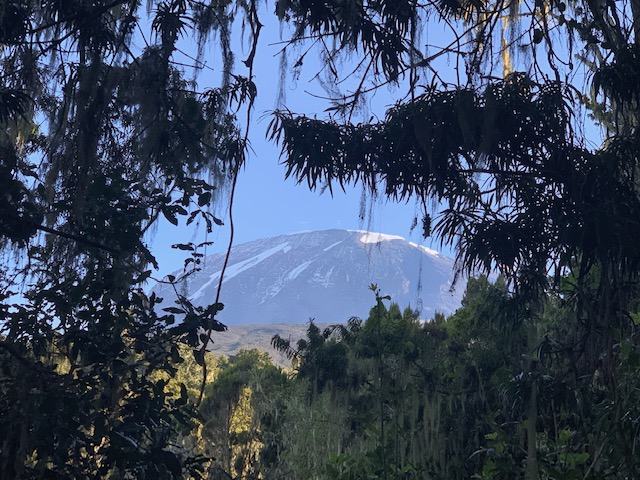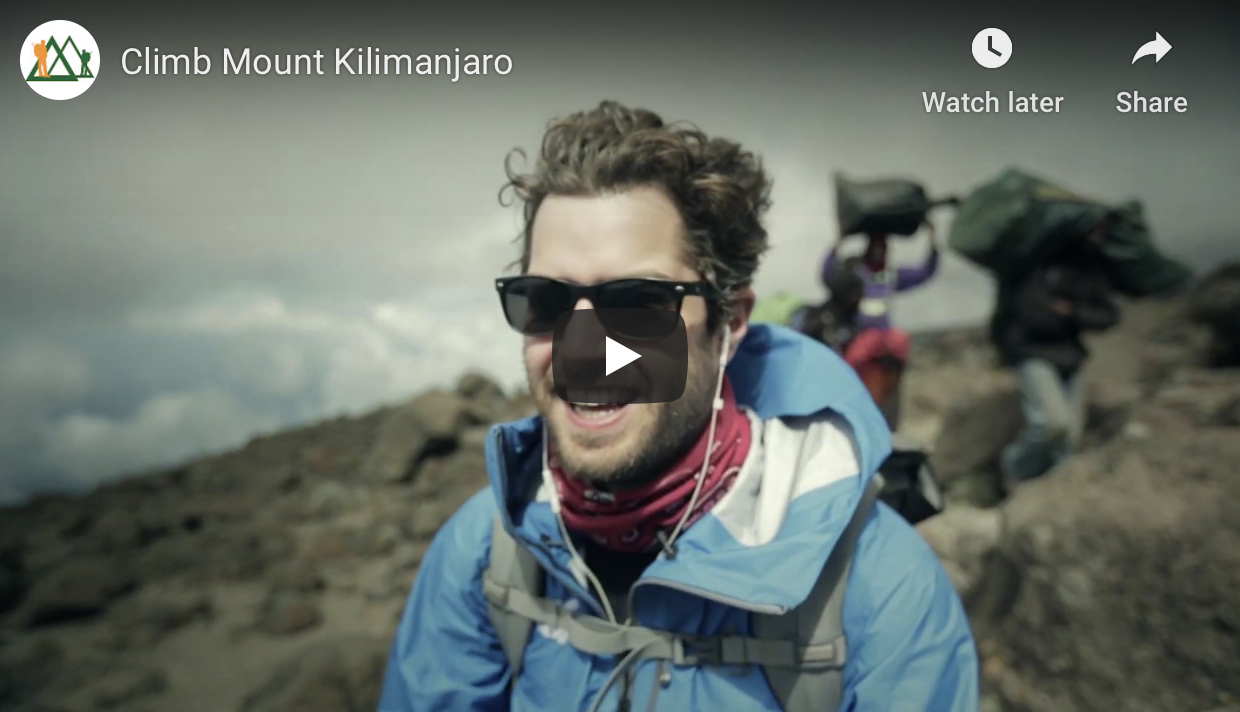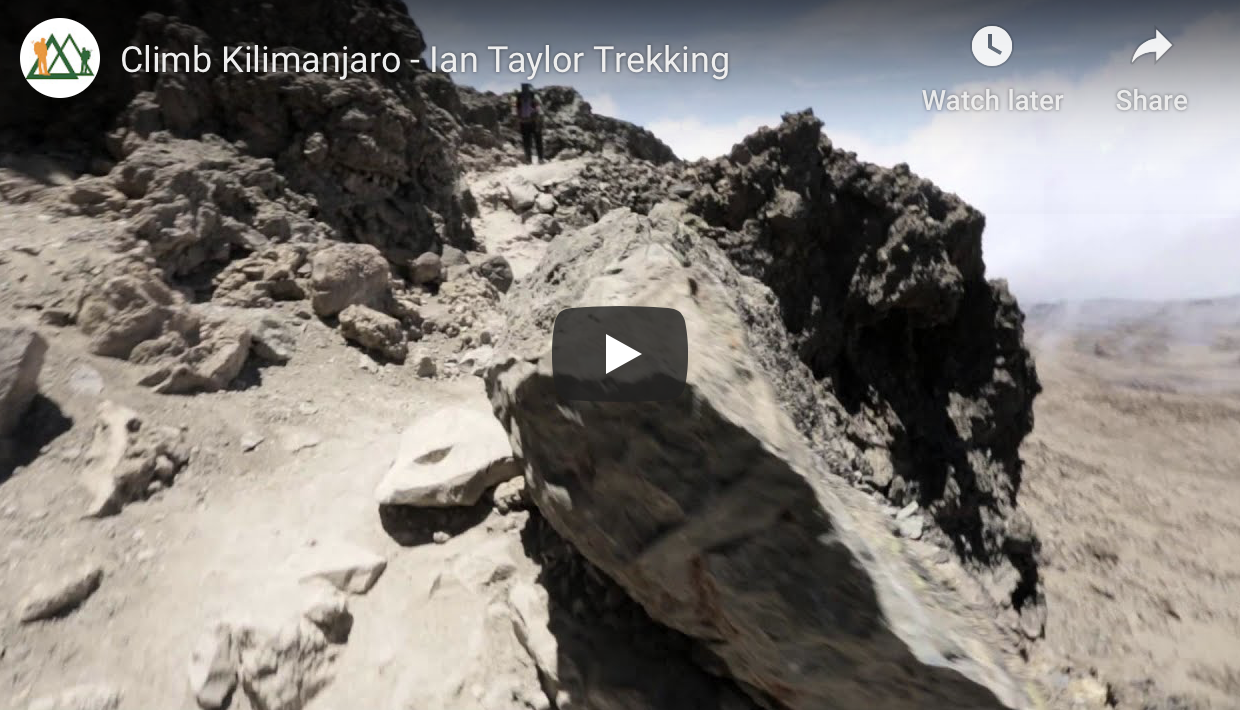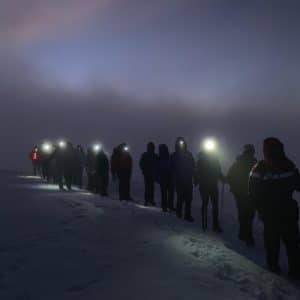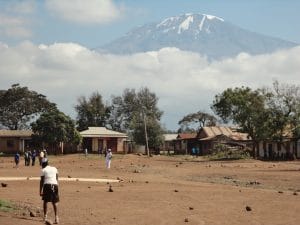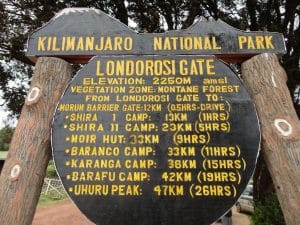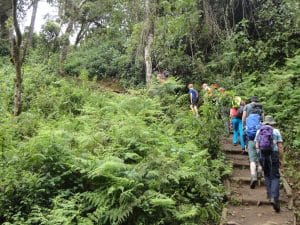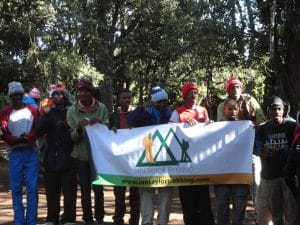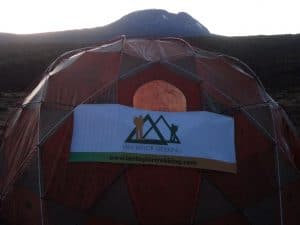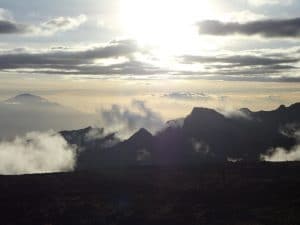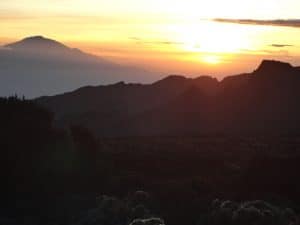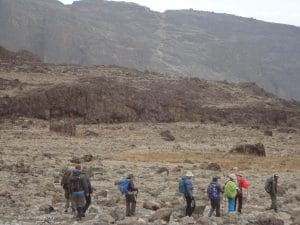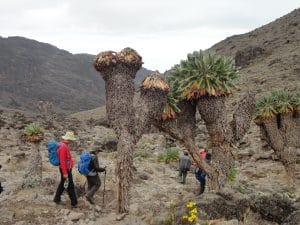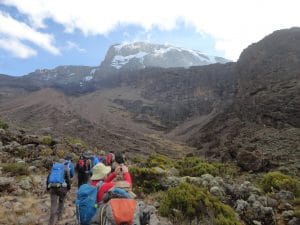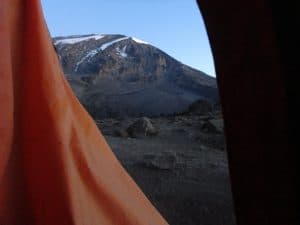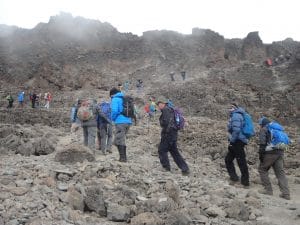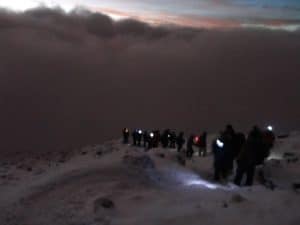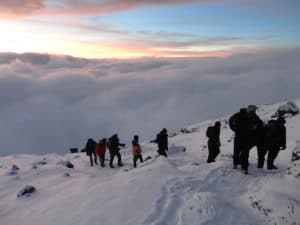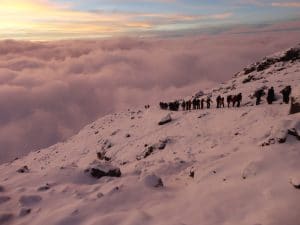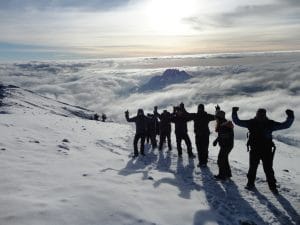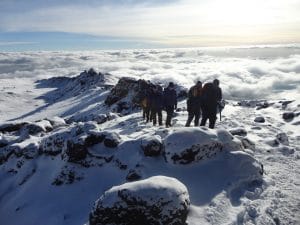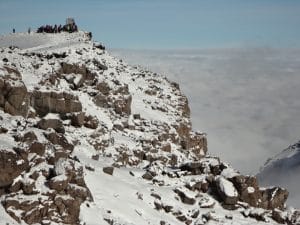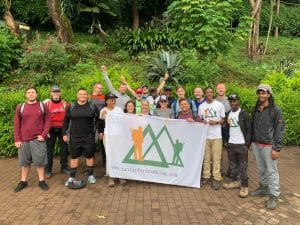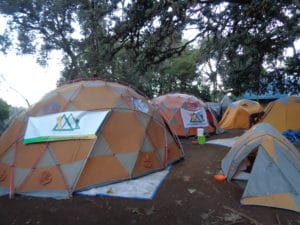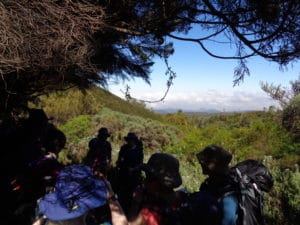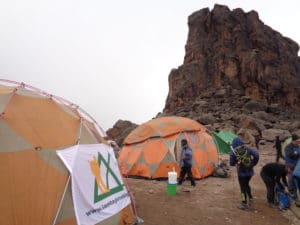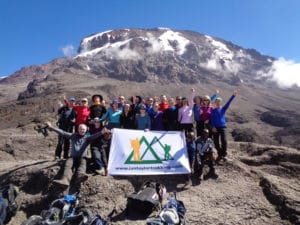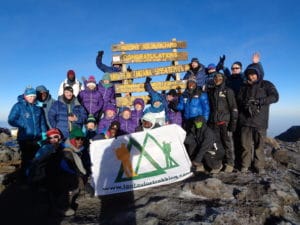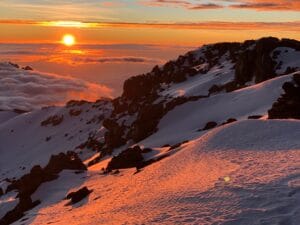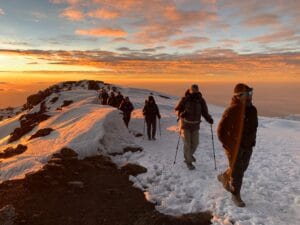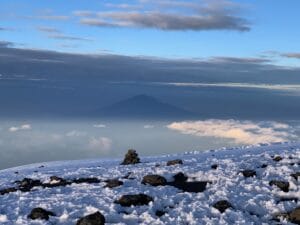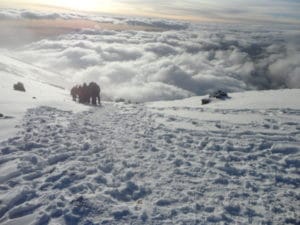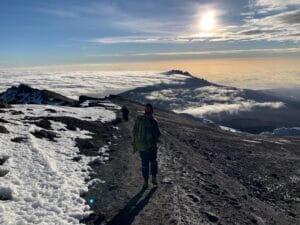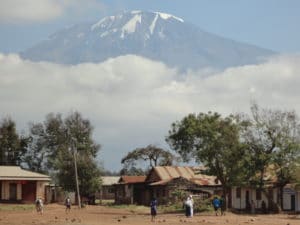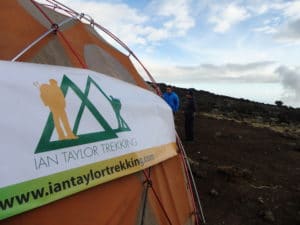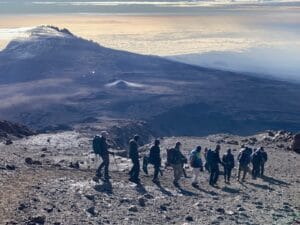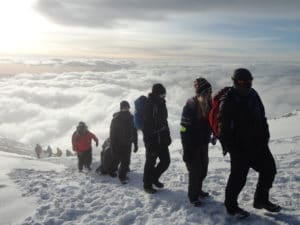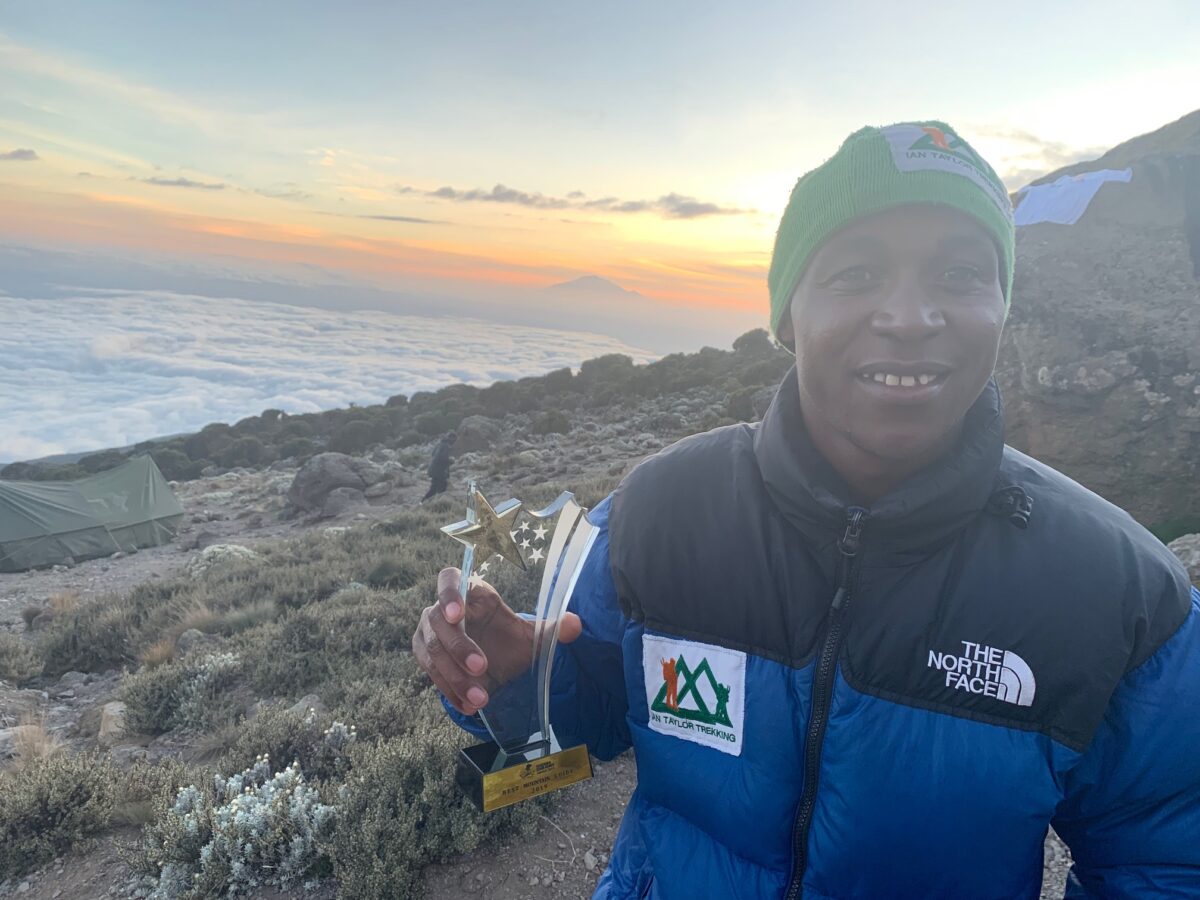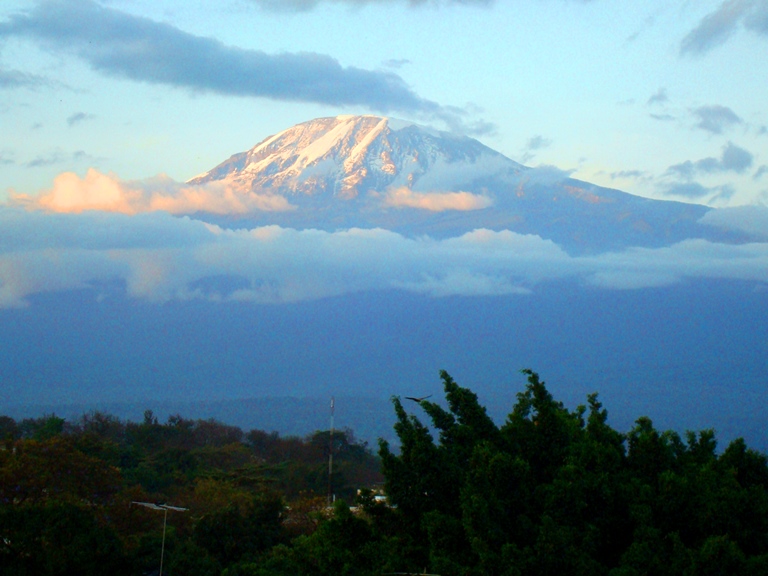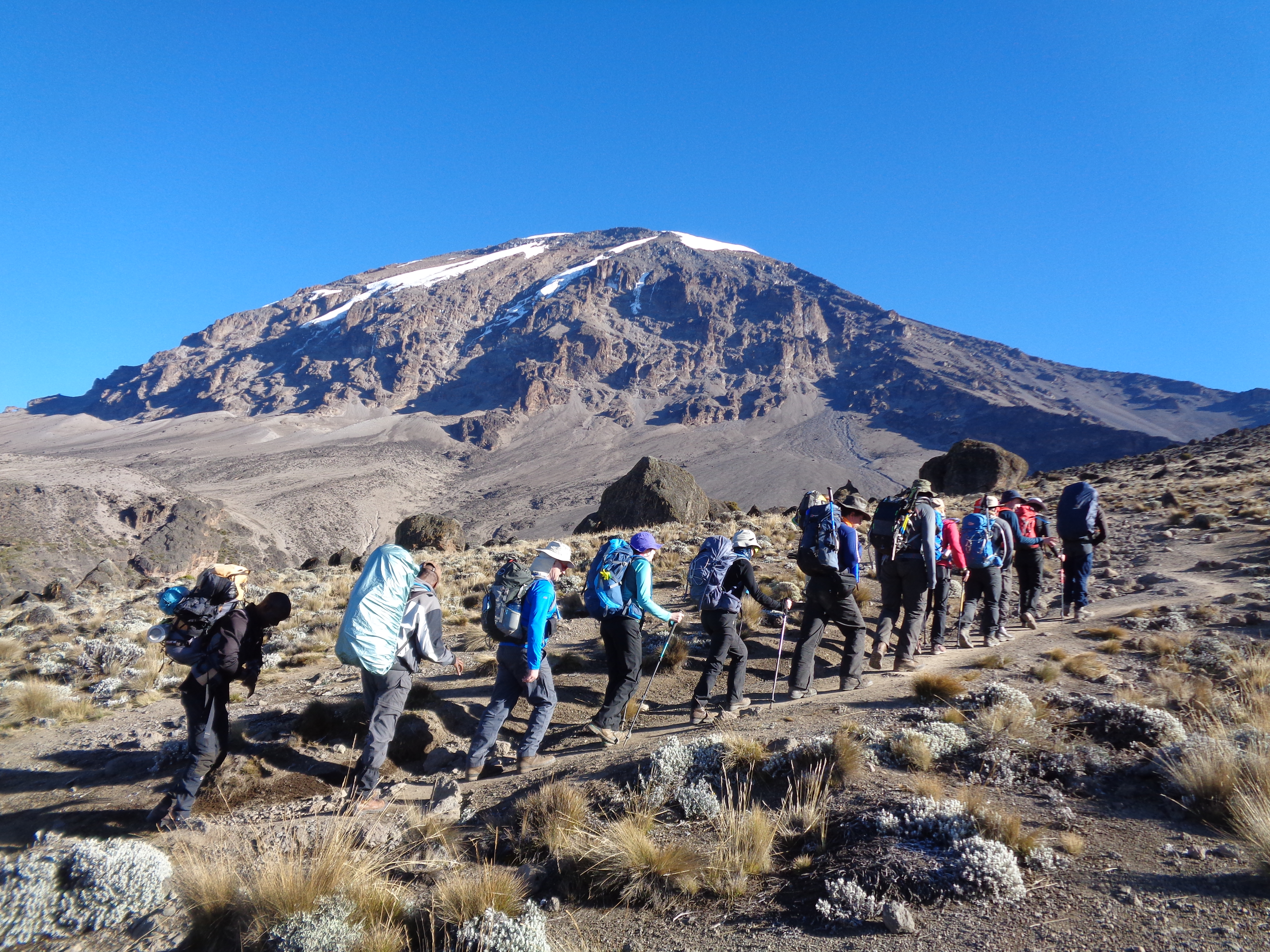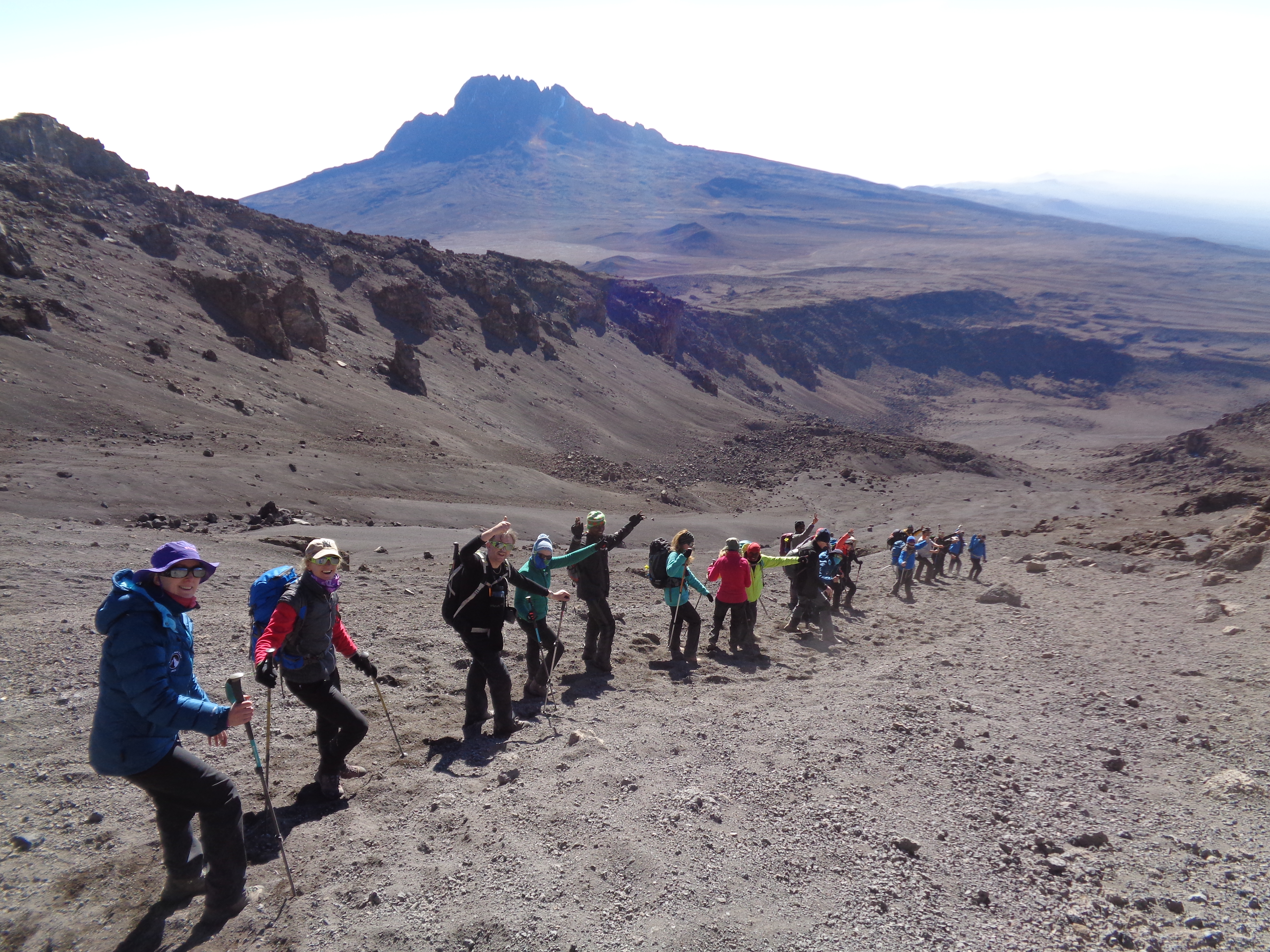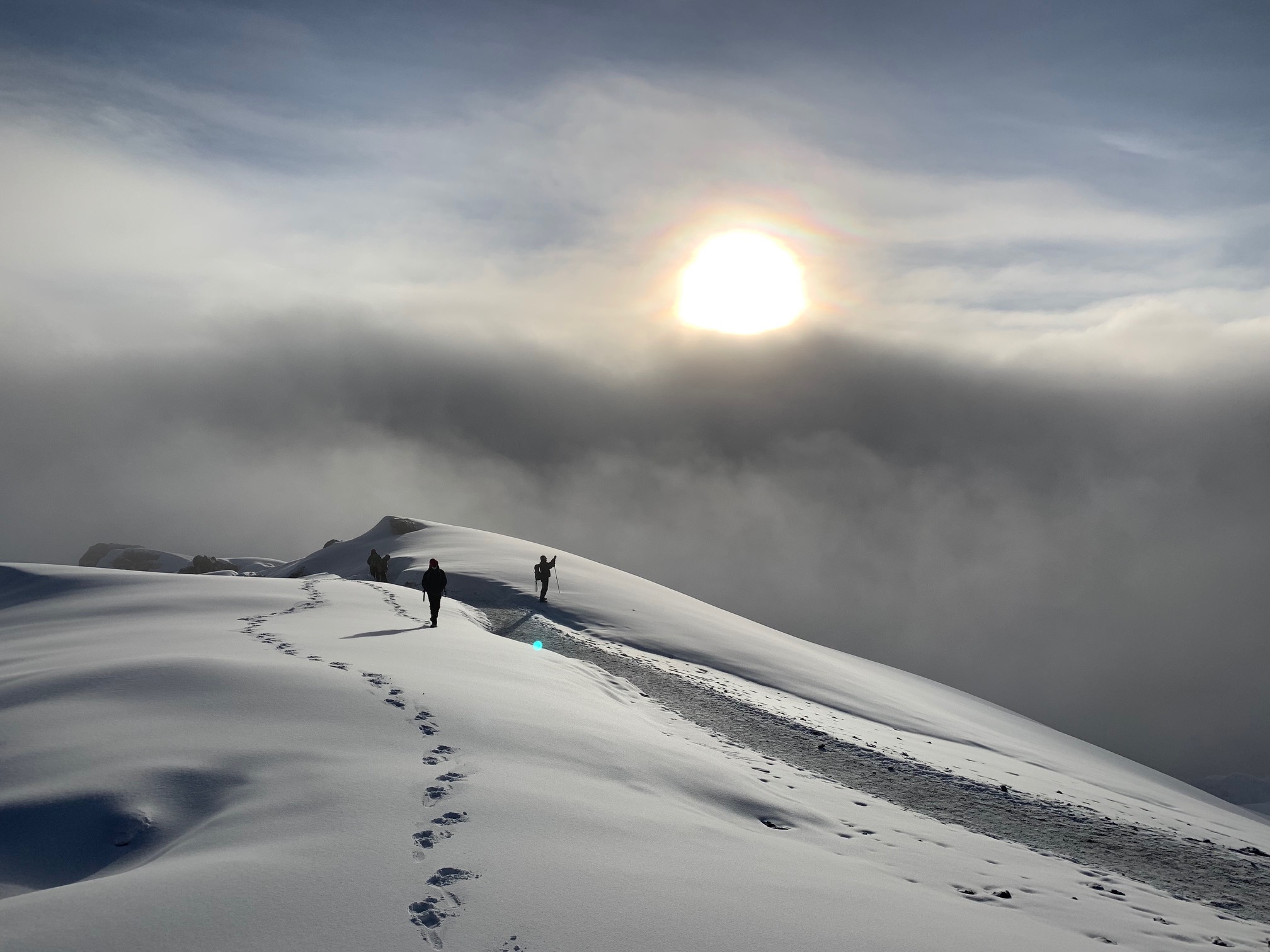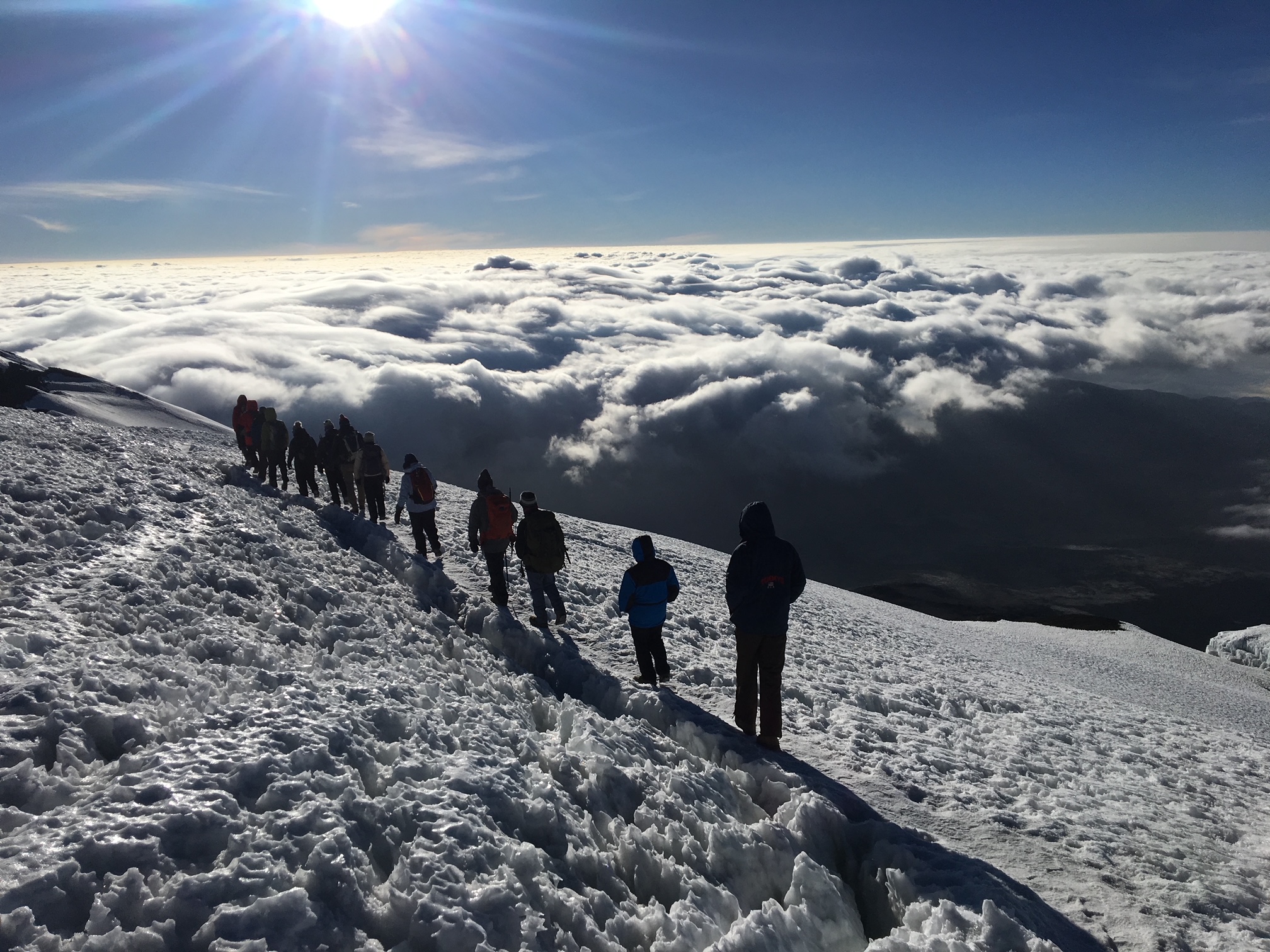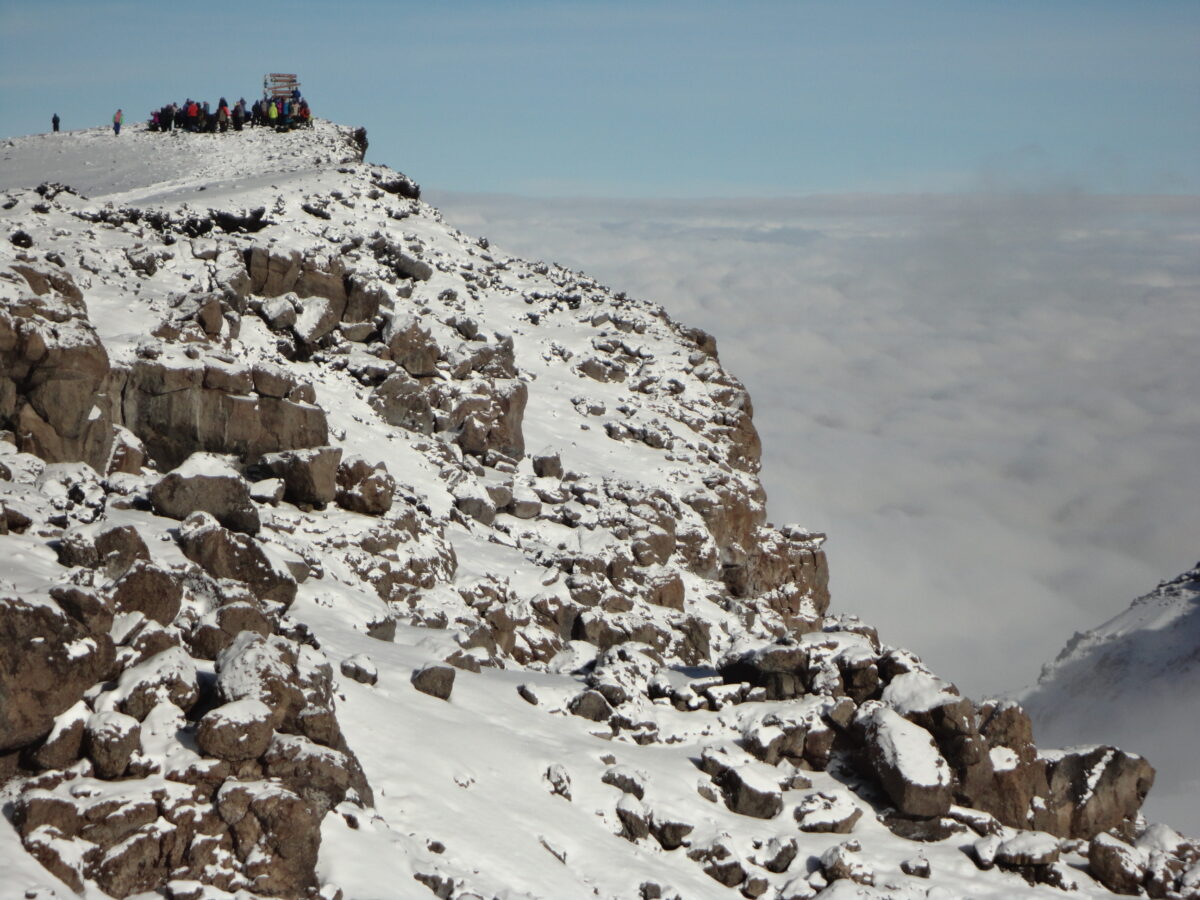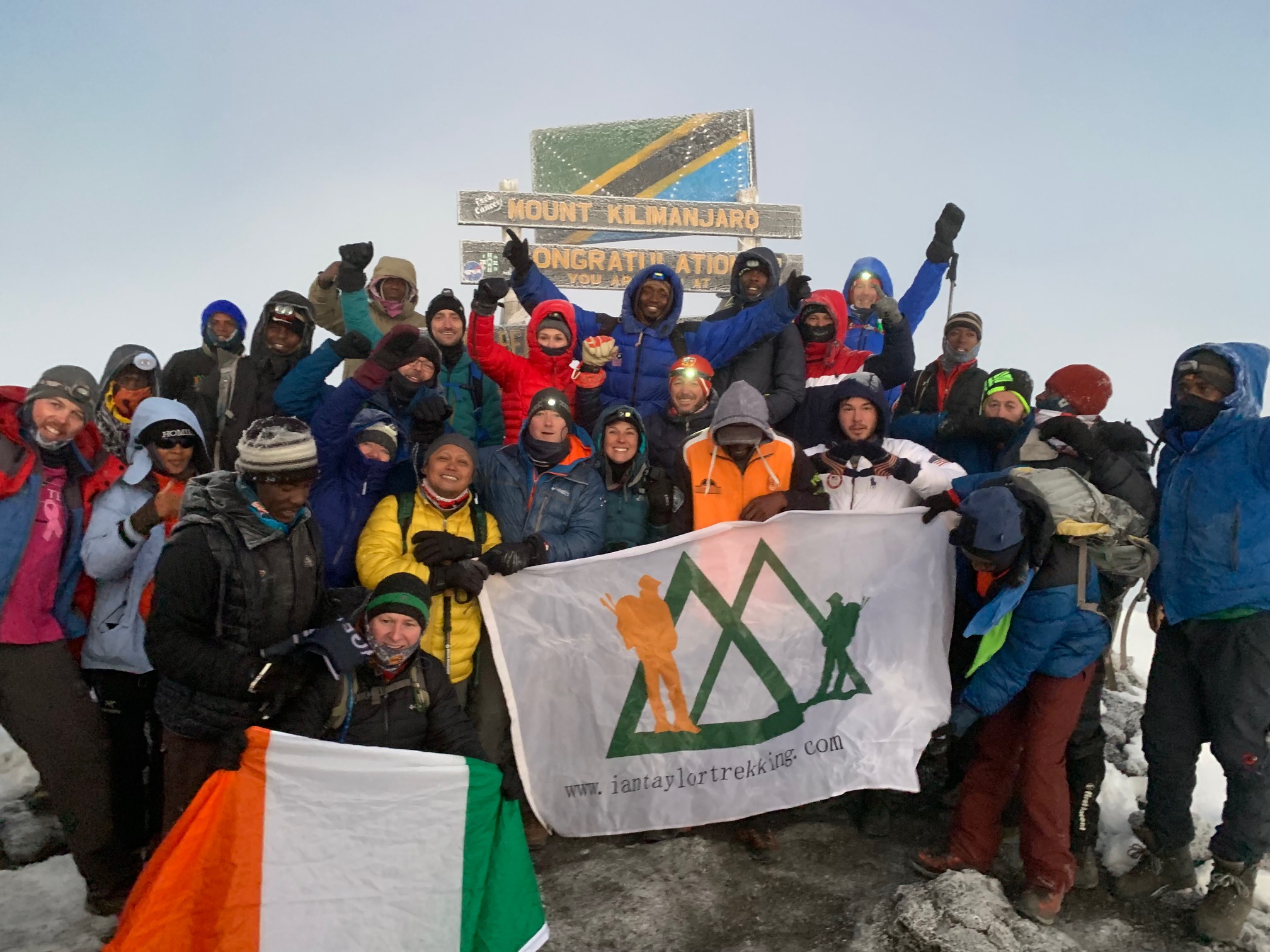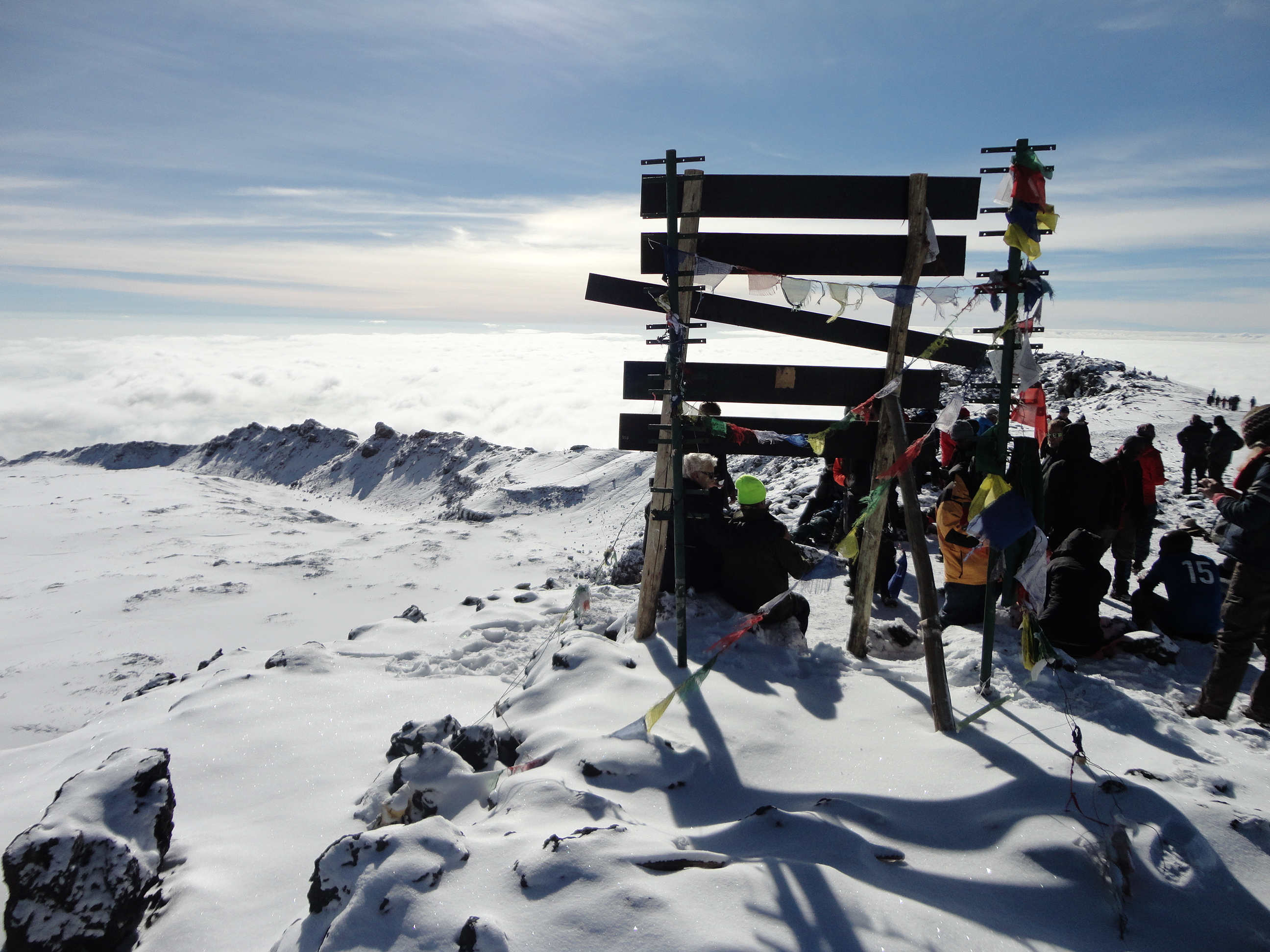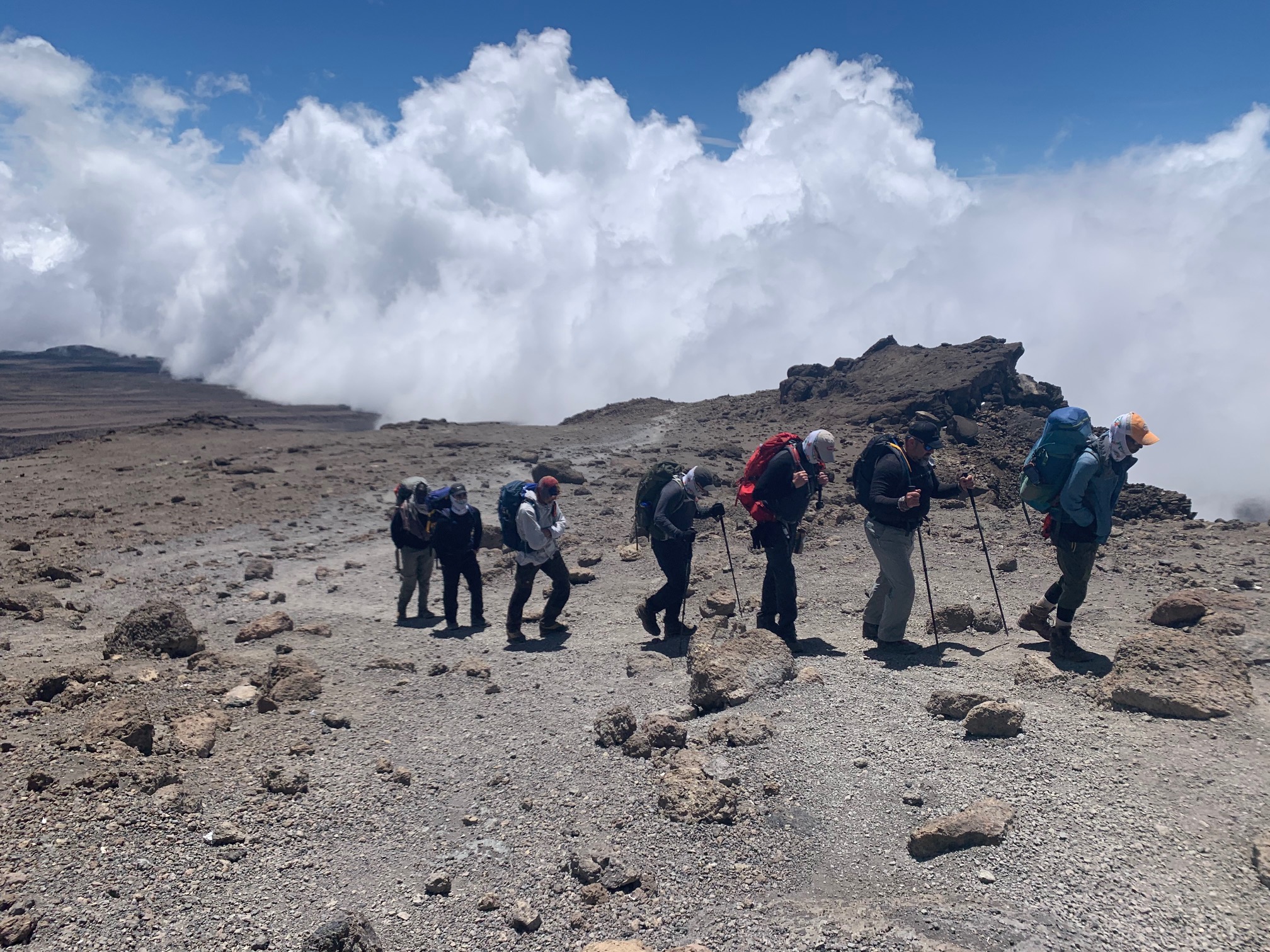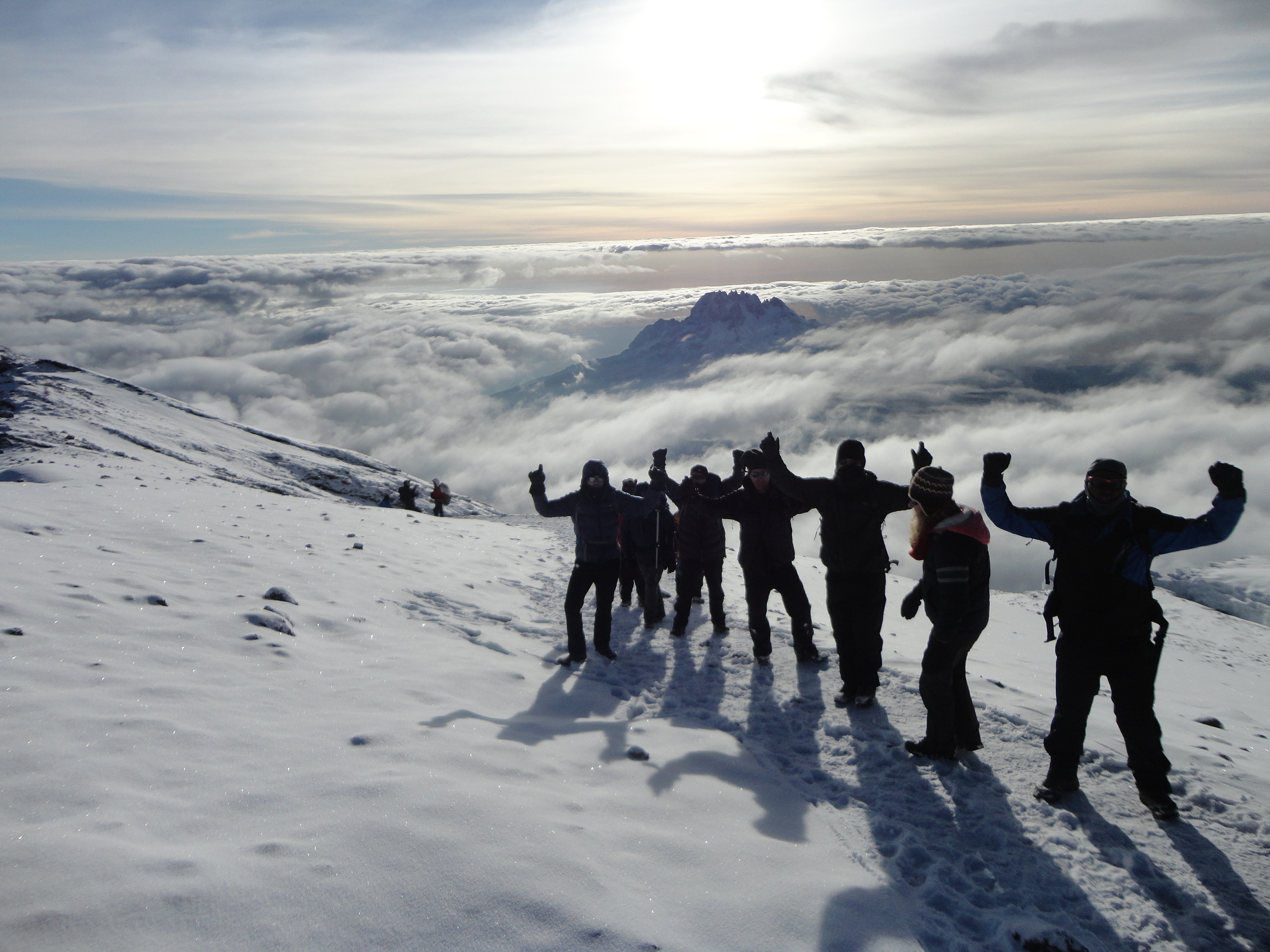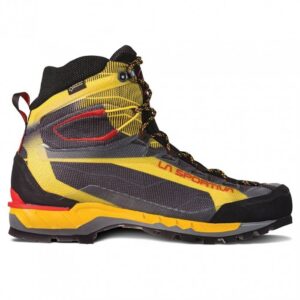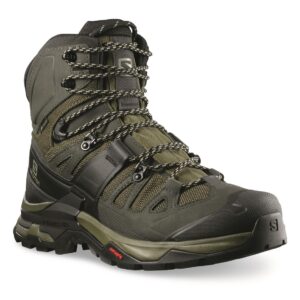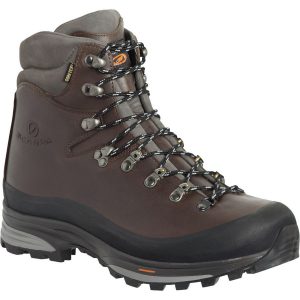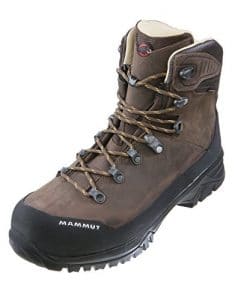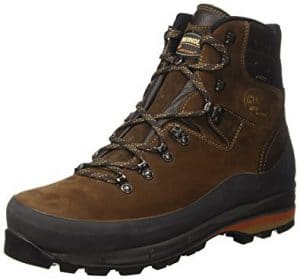Lemosho Route 8 Days
Join Ian Taylor Trekking on the journey to the Roof of Africa! We have full time and professional staff on the ground in Tanzania and are ready to help you reach your goals on Mount Kilimanjaro. Our Kilimanjaro climbs start at $3,650.
Tips & Advice
Making sure our clients have access to all the best information is extremely important to us! We have compiled all of our key pages on climbing Kilimanjaro here, in one location, so that you have one place to search for all of our advice. Remember, only less than 60% of people on any given year make it to the summit of Kilimanjaro. Don’t fall into this statistic!
The two biggest reasons are lack of physical preparation and lack of acclimatization. Because of this, we want to give our clients all the tools necessary to be successful. We have helped over 3,000 people to summit on our 8 day Lemosho Route climbs. Firstly, check out our Kilimanjaro climbing video, then check out our upcoming trips to Kilimanjaro.
Respect the Guides and Staff on Kilimanjaro
One of the first things that we emphasize to people wanting to go to Kilimanjaro is that we have to respect the local people who work on the mountain. Therefore, you must pay them well and treat them as family. This is how we approach our Kilimanjaro climbs! Our head guide was Voted The Best Kilimanjaro Guide. We have our own staff on the ground for 10 years now and don’t outsource our services. We have been building our expert team for 15 years, therefore making sure our team gives only the highest quality service. This definitely costs a bit more, however most companies cut corners in the areas of staff costs and service. Safety is our teams number one concern. READ SOME REVIEWS.
1). It’s official we have Kilimanjaro’s Number one Guide leading our team.
2). Pick the best acclimatization itinerary for your Kilimanjaro climb
3). Get training and learn the best way to prepare for your Kilimanjaro climb
4). Get FREE constant advice from our professional team
5). Understand the daily distances up and down Kilimanjaro
6). Have the right clothing and gear for your Kilimanjaro climb
7). Pacing each day on the trail is critical to success
8). Why hydration is critical at high altitude and in low oxygen environments
9). What sort of food will I be getting on my Kilimanjaro climb
10). These are the vaccinations needed for your Kilimanjaro climb
11). Get the Top 10 Tips available for your Kilimanjaro climb
12). The elevation gains on your Kilimanjaro climb
13). What are the best trekking boots for your Kilimanjaro climb
14). Where do I get Insurance to cover my Kilimanjaro climb
15). What are the best months to climb Kilimanjaro
16). What is the summit night like while climbing Kilimanjaro
17). What is the easiest way to climb Kilimanjaro
18). 20 reasons to pick Ian Taylor Trekking for your Kilimanjaro climb
19). How difficult is it to actually climb Kilimanjaro
20). Read some REVIEWS from our trips. Do to the Testimonial page.
21). Our TOP 50 TIPS for a safe and successful ascent of mount Kilimanjaro
22). Find out more about going on Safari in Tanzania with us
23). What our key elements to a successful Kilimanjaro climb.
24). What is the most beautiful route up Mount Kilimanjaro.
25). The truth about climbing the Baranco wall on Mount Kilimanjaro
26). Learn more about the best acclimatization for your Kilimanjaro climb
27). What does a normal day climbing Kilimanjaro look like
28). What additional expenses will you have on your Kilimanjaro trip
29). What are the two main differences between Climbing Kilimanjaro and the Everest Base Camp Trek
30). How do you train for hiking down hill. Learn more.
Join the Dream Team on Kilimanjaro
We have the same base camp manager, guides, servers, tent crew and generally the same 30-40 staff with us on each of our Kilimanjaro climbs. We have put over 3,000 people on the summit. Our staff want to work for us and give you a safe and amazing experience on the mountain because we make sure they are well looked after. Our head guide has trekked to Everest base camp and climbed Island peak with us in 2017 and Voted Best Guide on Kilimanjaro, and we are confident that others will follow.
Make Sure you Pick the Right Itinerary
One of the most important things you must consider when choosing your Kilimanjaro climb is how many days you will spend. A MINIMUM of 8 days on the mountain is needed to give you a safer and more successful ascent and descent. The more days the better. Any less than this and you are running the risk of falling into that 40% of people who do not make it to the summit because of serious altitude related issues.
How Important is Acclimatization
You need more time for the body to adapt to the lack oxygen, especially in the critical zone of 3,500m/ 11,482 feet to 4,000m/ 13,123 feet. You can not force this. Yes, everybody adapts differently to altitude, however you still need to be safe and careful and take your time going to new heights each day. Ideally, when going to altitude, you do not want to have jumps of more than 700m/ 2,300 feet, in one day. Above 3,500m/ 11,500 feet, you don’t want to make a jump of more than 500m/1,640 feet per day. The only exception to this should be for a summit night, when you reach the high point, then get out of high altitude quickly.
What are the Most Important Things to Know
Breathing techniques, low heart rates, excellent hydration and pacing are all extremely important to be safe and successful. You also need excellent physical conditioning to be able to walk up and down hills with a weighted backpack at high altitude. We can help you with this. So don’t wait, drop us an E-MAIL TODAY.
Who we Support in Tanzania
If you want to do more for the local people, then you can bring clothes, school items and gifts and we will deliver them to a local orphanage that we support. Alternatively, if you would like to support our porters to learn English and up skill, do let us know. We have staff looking to improve their knowledge and we can arrange this.
After years of running trips on Kilimanjaro, we have decided to compile a list of some of the most important things we have learned. Here are our top 50 tips as you start working your way to the summit of Kilimanjaro. We have helped over 3,000 people reach the summit and have 95% success on our 8 day Lemosho Route trips. Ian has climbed Kilimanjaro 37 times and our head guide on the mountain was voted Kilimanjaro’s Number 1 Guide. At Ian Taylor Trekking we run over 30 quality Kilimanjaro climbs each year. We are a world leader in offering quality climbs on Mount Kilimanjaro and happy to schedule a free personal assessment with you. CONTACT US.
All our office staff have all climbed Kilimanjaro many times, so if you sign up to one of our trips you are getting the best available information about how to train and fully prepare for your adventure. Read some REVIEWS from our trips.
1). Choose the Best Route
For a wide range of reasons, we believe our Lemosho Route itinerary is the best routefor your Kilimanjaro climb. We have designed our own unique itinerary for the best safety and success. If you want to be safe, successful and have the best experience possible, that that is the route to choose. Likewise, we also feel the Lemosho Route is the most beautiful route and has less people in the initial part of the trip. There are officially seven routes on Kilimanjaro, however the majority of them just go straight up the mountain. The Lemosho Route starts on the beautiful western slopes, encompasses the Shira Plateau, the stunning Barranco Valley all the way to the eastern side. We use Kosovo Camp above Barafu Camp for our summit attempt. Do yourself a favor, choose our unique itinerary on the Lemosho Route.
2). Have the Best Acclimatization Possible
We recommend a minimum of 8 days on the mountain. More acclimatization means a safer climb, it’s as simple as that. Likewise, it means an easier ride for the porters and guides. Overall, you will enjoy your experience so much more on Kilimanjaro if you have enough time to acclimatize. One of the biggest problems on Kilimanjaro is people trying to go up the mountain way to quickly, not allowing themselves the necessary time to acclimatize to the low levels of oxygen. We never recommend step foot on Kilimanjaro with less than a seven day trek and 8 days is best.
At 5,895m/ 19,341 feet, Kilimanjaro’s summit is in the extreme level of altitude and not to be underestimated. The reason most people do not make the summit is that they choose a 5 or 6 day trip. Choosing a shorter trek on Kilimanjaro will definitely save you money, however what is that worth if you don’t make the summit. Yes, the trip in 8 days will be more expensive, however, there is no point going on the mountain if you don’t give yourself the best chance for success. Therefore, in our opinion, the only option is the 8 day trip up the Lemosho Route. Happy to chat with you if you would like further information on why acclimatization is critical for safety and success.
3). Train, Train, Train
This is a challenging question to answer. It will depend on your ability, experience, age, weight. All these factors need to be considered when you are thinking of climbing Kilimanjaro. Kilimanjaro is a peak that is accessible for most reasonably fit individuals, but you do have to physically prepare your body if you want to fully enjoy your adventure. I would recommend that you spend at least five days a week doing some sort of intense physical exercise for approximately six to eight months prior to your starting date of your climb.
We recommend that you spend at least four or five days a week, doing some sort of intense physical exercise. This should be done for approximately six to eight months prior to your start date of your trek. We recommend spending at least four days a week either walking up hill on a treadmill or on a stair-master (stair master is best) for one to two hours a day. You will also want to build up to carrying 10-12 kilos (22 – 25 lbs) in a backpack on your back.
Doing this type of daily training sessions, along with one longer day a week out in the hills, is ideal. In your longer session in the hills, you will want to walk from 4 – 7 hours, going up and down hills with the weighted pack on. I cannot stress enough how important this is to your training. CONTACT US and learn more about what we recommend.
4). Bring the Right Gear
Choosing the right gear and clothing is important. We have the most watched Kilimanjaro packing video on You Tube. If you sign up to one of our Kilimanjaro climbs we send out our 40 page document with an itemized kit list for climbing Kilimanjaro. There are many pieces of gear and clothing that are essential for our trip on Kilimanjaro, and I am not going to go through every piece of gear you need for the trip, I am just going to highlight some of the specific pieces that I found to be essential.
First of all, your feet are one of the most important parts of the body to take care of when trekking. Never skimp on footwear when you are going on a trip like Kilimanjaro. Buy a good, sturdy, waterproof pair of trekking boots and make sure that you break them in before you leave for Africa. Number two, buy yourself a good down jacket with with more down. Not a lightweight 800 fill down jacket. Remember that every brand and style is different and if you are questioning your down coat, make sure to ask our advice before the trip.
Number three, having both a water bladder (i.e, Camelbak brand) and two Nalgene style plastic bottles. Drinking water is essential on the mountain. Lower down, you will use the water bladder to get in enough water, however for the summit night this will freeze. So you will need the Nalgene bottles.
These three gear tips are obviously not the only gear you will need on the trip, however these are some of the essentials. Watch our Kilimanjaro packing video for further information. We are always available to help make sure our clients have the correct clothing.
5). Get the Trekking Boots Right
Having the right trekking boots for your Kilimanjaro climb could make or break your trip. Your boots need to be warm and well insulated with excellent ankle support. Check out some of boots we use and recommend. Different brands have designed and your foot shape might suit your foot type. We highly recommend trying on your boots in store and testing them in on a ramp and stairs in order to make sure they fit properly. Don’t forget to try them with your summit socks too! These boots will take some time to break in, therefore you want to make sure they fit correctly. Take some time to make sure they work for you. Try on a range of different brands until you are happy with the fit.
6). Use the Best Guides
Our Head Guide was voted Kilimanjaro’s Number 1 Guide. All our guides have gone through rigorous training and we have continual training available to them on the ground in the off season. Another one of our head guides has climbed Kilimanjaro over 500 times with 25 years experience working on Kilimanjaro. Our team is more of a family to us and they all know us personally.
7). Investing in the Local Community
Make sure you pick a team who have their own full time staff on the ground. All of our trips are based out of Arusha, Tanzania, and we have our own Ian Taylor Trekking staff on the ground in support of your climb. We invest in our staff, sending them to college and invest in them continually. We also have training available to staff that show they want more responsibility. Throughout the years, we have developed and trained guides who used to be porters. They have worked their way up to tent crew, kitchen staff, servers and now they have become our guides. Many of these guys have been working with us for over eight years now! We pay for their training and cover the college costs and in turn they work hard for us on every trip.
8). Learn From the Experts
You need access to professional Kilimanjaro Guides 5 days a week prior to your climb. If you are planning a mountaineering adventure like Kilimanjaro don’t go to a travel agent. Book the trip with mountain experts. All of our office staff have climbed Kilimanjaro over 5 times. Ian has climbed Kilimanjaro over 35+ times and is available daily in support of your climb. Make sure you are getting all the up to date information on how to plan and prepare correctly for your Kilimanjaro climb.
9). Have More Staff on the Mountain
A lot of companies cut corners. At times, you may see a group of 20 clients with one guide. We have seen groups of 10 clients with 1 guide. That is not how we want to run our trips! Your safety is our number one priority, so we think it is essential to have extra staff on the mountain with our teams. We have 4 to 6 kitchen crew, security team, more porters, guides and normally have 40 staff for a group of 10 trekkers.
10). Security on the Mountain
Unfortunately, there have been instances on Kilimanjaro where people are having things missing from their tents or luggage. We hear of groups being in their dinner tent or else on an acclimatization walk during the afternoon. They come back to their tent and find that someone had been in it, and taken items. That does NOT happen on our teams! We have a security team on the mountain that are always watching over our teams when we are not in the tents. So when we are eating meals, on an acclimatization walk or going to the summit, you don’t have to worry about your valuables going missing!
11). Comfortable Tents
We use Mountain Hard Wear Trango 4 tents. These are 4 person tents that we only have 2 people sleeping in. They are warmer, more spacious and more comfortable. Remember you spend a lot of time in these tents. Sleeping is a critical part of acclimatizing and having more space adds to your comfort level on the trip. We also use a Mountain Hard Wear Dome Tent with comfortable camping seats and the best food available.
12). Having a Professional Chef
Preparing high quality food is challenging under normal circumstances, however our chef and assistant chefs are preparing quality food on the side of the mountain. We serve you with three, three course hot meals each day on the mountain. Our food and food menu is specifically designed to match the needs of each day climbing Kilimanjaro. We can also cater to your dietary restrictions. Check out our food menu for your Kilimanjaro climbs and feel free to get in touch for further information.
13). Mental Preparation for the Climb
Mentally prepare for the journey ahead! Depending on your level of comfort with the outdoors, you may need to prepare yourself for life on the mountain. Hopefully if you are signing up to a trip like this, you are a lover of the outdoors and very comfortable with the mountain living! The trip will include camping, bugs, dirt, baby wipe showers, and going to the toilet outdoors! If you are not used to rugged conditions, you will want to prepare yourself for what is to come.
14). Do Some Camping Prior to the Trip
Some people do struggle with living in a tent. Our advice is to go camping, test your sleeping bag, Thermarest or Air Mattress and get used to being in this type of environment. Remember you will be spending 10+ hours in this tent each night so coming with previous experience makes you feel more at ease. Some people use the backpack as their pillow, however maybe you need to invest in lightweight pillow. Having dry bags in your tent and having them labeled may also help you find cloths and items you need in the tent. This will cut down on the stress levels and make you more efficient while camping on Kilimanjaro.
15). Testing your Gear
We will provide you with an itemized kit list prior to the climb. You need to get outdoors and test each piece of gear. You know that you need to break in your trekking boots, but you also need to test all of your other gear as well! Make sure your Thermarest does not have a hole in it. Test your head torch and have spare batteries for it. Make sure your backpack fits correctly and not causing you any problems. Check there is no mold in your water bladder and check your medical kit. Test each piece of gear and clothing you are planning on bringing with you. You also want to make sure everything fits into your duffel bag and backpack and that you do not have more than 15kg/ 22 lbs in your duffel bag.
16). Oxygen
Make sure your team has oxygen bottles with them. Every group on Kilimanjaro should have oxygen, but they don’t. Oxygen should be carried with the groups, at all times on your way up and down Kilimanjaro.
17). Do you Need New Trekking Boots
We have seen people pull trekking boots out of there bag and the sole is about to fall off. Break in your Trekking boots but make sure they in good shape before you leave home. You do not want blisters on your feet at any stage of this trip, so check your boots a month before travelling to Tanzania.
18). Satellite Phone
Mobile phone coverage can be patchy to non-existent on Kilimanjaro. We highly recommend that you climb with a team that has a Satellite phone or GPS device on hand. If an emergency happens on the trail or high on the mountain you need to know quick action can be taken.
19). Have more Support on Summit Night
We have one to one support for you on your summit night and summit attempt. For your safety and comfort we always have one guide or support staff with us for each client. The guides will carry hot tea, medical kits and oxygen. We don’t want guides to carry your backpack for you up the mountain. They will support you down the mountain if your safety is compromised.
20). Hydrate Before Arriving in Tanzania
Hydrate before you come on the Kilimanjaro climb. Each day on the mountain you will need to be drinking 4 to 5 liters of water. It is important to get used to drinking similar levels of water a few weeks leading up to the trip. You should be drinking 3 liters at home anyway. Being used to drinking more water prior to the trip will help you when you have to drink more each day on Kilimanjaro.
21). Portable Team Toilets
Having your teams own private toilets make a huge difference. The National Park is building new toilets all the time, however many of them are not well maintained. We bring two to three portable toilets with us on each trip. If you need to go to the toilet in between camps you should bring some zip lock bags and collect your toilet paper and you can dispose of it when you arrive into the next campsite.
22). Hydration is Critical
There are many elements in having a successful climb up Kilimanjaro. Hydration is certainly one of the more important ones. If there is one tip that we can give you while on the mountain, it is to make sure that keeping yourself hydrated is one of your top priorities. At higher levels of altitude, your body will dehydrate much quicker than it will at sea level, and you will have to make sure you are drinking plenty of water. I would recommend that you are drinking around four to five liters of water throughout the day while on the mountain. This is where the different types of water bottles come in handy.
Our goal on the mountain is always to try and drink one liter of water in the morning before you start walking. Then, if you fill your bladder with two liters of water, you can drink that until lunch time, while you are walking. The staff can re-fill your bladder at lunch and you can continue working on finishing two more liters before dinner time. We always suggest to people to try and have all of your water drank before 5pm. This way, you will not be waking up all night, having to go pee. This process of drinking five liters of water a day can be daunting to many, however it is essential to people’s success on the mountain.
23). Cover for Your Water Bladder
Make sure you have a cover for the nozzle of your water bladder hydration system. Kilimanjaro can be dusty in the dryer months so you do not want dust or dirt building up on your hydration device. You do not want to get sick on the mountain so cleaning the mouth piece with sanitizer daily is also a good idea.
24). Bring Hydration Salts
Having Nuun hydration tablets or Dioralyte sachets are a great idea to make sure you are staying hydrated. We like to use hyper hydration sachets for the summit night, but you should seek medical advice on this. As we have mentioned before hydration is so important at high altitude so do consider bringing some sort of supplement that supports hydration.
25). Bring Multi-Vitamins
Make sure you bring and are taking a multi-vitamin before and during your Kilimanjaro trip. You need to should being eating healthy before the trip aiming to come to the mountain with a strong immune system. Staying healthy on the mountain is going to be one of the most important factors, so taking the vitamins throughout the trip is essential.
26). Consider Other Vitamins
Ian has been leading treks and expeditions for over 15 years now. Very rarely does he get sick on the mountain and he puts it down to the fact he always brings a wide variety of Vitamins. Normally, Ian will be going directly into another climb after a trip, so he can not afford to get sick. He will always take 1,000 mg of Vitamin C daily. He also takes Vitamin B complex, Garlic, Selenium, and Beta Carotene. You should consult your doctor or nutritionist as to what vitamins you should be taking to remain healthy in your training and while on the mountain.
27). Do not Show up Sick
If you join sick we may have to send you home. Activate your insurance and reschedule your trip. You run the risk of getting other people sick and ruining their once in a lifetime trip. Your sickness could also have an adverse affect on our staff. Also if your immune system is weak you run the risk of getting much worse and limits your chances of reaching the summit.
28). Have the Correct Gloves
You wouldn’t show up on Kilimanjaro with out a sleeping bag, air mattress or trekking boots. So don’t show up without the right gloves. From experience, if you are going to feel the cold you will feel it in your hands and feet. We have seen so many people saying ‘help me…my hands are cold’ on the trail. They always have inadequate gloves on! Invest in the right gloves, so that this is not you. Make sure you test these gloves and they fit correctly. You should be able to fit a liner glove under your bigger/summit glove.
Normal temperatures on the summit at 6 or 7 am are usually around minus 8 Celsius or 17 Fahrenheit. It can be a little colder if the wind it high. You will feel colder because of the lack of oxygen. If you know your hands run cold, you should consider the bigger glove like the Black Diamond Guide Glove.
29). Take Diamox
We highly recommend taking Diamox on Kilimanjaro from start to finish. Always consult your own Doctor prior to the trip. Our doctors recommend 125mg morning and 125mg late afternoon. This can vary on the person, symptoms and a range of factors. Make sure you are not allergic to sulfa’s. Always check with your own doctor before taking any medications.
30). Alternatives to Diamox
If you are not keen on taking Diamox or if you are allergic to Sulfa medications, there are a few alternatives. Remember there is no substitute for good acclimatization and having more days on the mountain decreases your risk of getting altitude sickness and going home early. Ibuprofen is tried and tested for using at altitude and we recommend having Ibuprofen with you. At high altitude your brain is swelling which gives you headaches and makes it challenging to sleep. Taking Ibuprofen decreases inflammation and can ease headaches and help you sleep at altitude.
31). Slowly Slowly or Pole Pole!
If you want to limit your chances of fatigue on the mountain. You need to travel with professional guides who know how to pace each day of the trip perfectly. Pacing at high altitude is critical to success. We truly believe that having the right pace each day is one of the most important elements of a safe and successful journey up and down Mount Kilimanjaro. We always allow other groups pass up on the way up the hill. The goal on our trips is to get from one camp to the next, using as little energy as possible. We manage the pace of our trips differently than other groups to achieve this.
32). Stay out of the Sun
You are going to have enough challenges to deal with when going into a low oxygen environment. Don’t add sunburn to that list. We have seen hundreds of people get sunburn in the early part of the trip and have to go home early. We have seen people getting headaches and diarrhea from too much sun. With limited UV protection in low oxygen environments you need to be protected from the harsh rays of the sun. Use a brimmed hat, long sleeves and factor 50 sun screen. If you get burned you add to the list of problems you can have on the side of a high altitude mountain like Kilimanjaro. Always cover your head.
33). Bring Additional Protein Bars
Our food and menu is second to none on Kilimanjaro, but you might want to consider additional protein bars. We usually bring around 4 protein bars with us on every trip and can be useful on the longer hiking days. Everyone is different and some people need to be snacking throughout the day. Protein bars are a great snack and useful. This was mentioned before, but bringing a small bag of trail mix for the summit night along with a couple of packets of energy chews is always helpful. We have plenty of food on our trips and you do not need bags and bags of snacks.
34). Bring a Battery Pack
We use a Ravpower Bank 22000 mah/ 83.6 wh. Always turn your phone to battery saving mode and turn it off during the nights. If the temperatures are very cold, then keeping the battery pack and phone in your sleeping bag can also help to hold the charge. This power bank gives us enough charges for the entire 8 day trip on Kilimanjaro.
35). Bring a Solar Panel
Another option is to bring a light weight solar panel. There are plenty of options out there on solar panels and they can give you that essential charge when needed. Just remember, if it is cloudy, you may not get any charging on the mountain. Do not rely on a solar panel for charging your all important phone / camera. Either bring an additional camera or have a battery pack.
36). Sunglasses
Always wear a sun hat and sunglasses at all times. Protect your eyes from the sun especially if there is snow on the ground. Remember there is less protection from the sun at high altitude. Protect your eyes with category 3 or 4 sunglasses. Don’t skimp on these!
37). Keep Batteries Warm
Make sure wrap up your batteries during the cold nights. Keep your head torch and spare batteries rapped up when it is cold. Sometimes, on very cold nights, we recommend sleeping with batteries and your phone in your sleeping bag. You don’t want to get to the summit after all the hard work and not have any charge left to take your pictures!
38). Bring Some Dry Bags
No matter what time of year it is, you can experience rain on Kilimanjaro. There have been times when it is technically the ‘dry season’ and we have had teams experience rain daily on the trail! You are in the mountains and they have their own weather systems! Having dry packs are very useful to keep your key items dry. Most duffel bags are water resistant, but not fully water proof. Water can get into your duffel bag through the zippers. Dry bags are also very useful in separating your gear. Try and separate clothing, snacks and electronics into separate bags, then label them. Keep a separate bag for dirty clothes and one for dirty shoes.
39). Bring Some Plastic Bags
You will need a separate bag for your trainers or camp shoes so you are not getting dirt on your clean clothes. When you are walking around campsite you will pick up dirt and dust and you want to keep this off the rest of your gear. You will also need some small bags for collecting your toilet paper on the trail if you are going to the toilet between camps. Please do not leave any trash, paper or rubbish on or off the trail. LEAVE NO TRACE.
40). Use Your Trekking Poles
You should consider using trekking poles or at least one trekking pole for Kilimanjaro. They are very useful on all down hill sections of the trail. We high recommend using poles as they will help protect your knees and also shift some of the stress to your upper body. If you are not used to using trekking poles, practice using them in your training hikes so that you can be comfortable with them. Always get the adjustable poles that have clips. The older screw up versions tend to stick and break much quicker. We can help you sources the best options. We also rent trekking poles.
41). Have a Separate Set of Clothes for Sleeping
When you arrive into camp you will want to get into your tent straight away and start setting it up. Get your air mattress and sleeping bag out. Hot water for washing will come soon. While you are waiting for the hot water you can change your clothes and have a baby wipe shower. I Always keep one pair of socks and change of underwear and base layer for changing into. It is nice to put on these cleaner items along with fleece pants, fleece jacket and down jacket to be as comfortable as possible each day.
42). Fill Your Nalgene Bottles at Night with Boiling Water
One of the main reasons we recommend Nalgene Bottles for the trip is so that on cold nights, you can have them filled with boiling water. You can then slip this bottle in your sleeping bag, to act as a hot water bottle! It will keep your sleeping bag nice and toasty! What we recommend is bringing you Nalgene Bottles into the dining tent at dinner time. You can give the bottles to our servers and when dinner is over and the briefing has been given, the kitchen will have been boiling water. You can retire to your tent with a small comfort, knowing that you have a hot water bottle. Only use Nalgene bottles for this. Other brands can melt and do not put boiling water into your water bladder.
43). Have Extra Insulation
As we have said before, sleep is critical on the mountain. You need to sleep and be comfortable while you are sleeping. If you are cold in your sleeping bag it may be because you need extra insulation. Remember you need body heat to heat up your sleeping bag. Do not start wearing all your clothing in the sleeping bag. This will trap your body heat and make you colder. The best thing to do is putting down vest and your down jacket down in by your feet or wherever you are cold. You can also use other layers around you in the sleeping bag. This will add additional warmth.
44). Dry Shampoo can be Useful
Consider bringing some dry shampoo along with a small bar of soap. You will receive hot water each day on arrival in camp and you may want to wash your hair at some point. You may just want to stay with the baby wipe shower. Using dry shampoo is just another comfort that you might want to consider.
45). Nail Clippers
Make sure you bring nail clippers with you. You might need to keep your nails trimmed to keep dirt from getting under your nails and keep you from getting sick. Also, you want to clip your toenails before the summit night and long descent down Kilimanjaro. You can also consider bringing a nail brush for your finger nails.
46). Focus on One Day at a Time
It is inevitable that you will be thinking about the summit night and whether or not you have what it takes to make it to the top. Don’t be thinking too much about the summit and enjoy each day as it comes. The journey is far more important than the destination, so focus on doing the right things from the beginning. Drink lots of water and do everything slowly. The best climbers are the ones who are the most relaxed. This experience climbing Kilimanjaro might just change your life so be present and enjoy each day as it comes.
47). Keep your Tent Organized
When you arrive into camp each day, get a routine in place for how you want to manage your tent, clothing and items. When we get to camp, we like to recommend to get into the tent, set out your air mattress and sleeping bag. If you bring an inflatable pillow, blow it up and start getting comfortable. Change into your camp clothing, new socks, layers and do a quick wash. Then get your toilet paper out, toiletries lined up Nalgene bottles ready to go. You want to have your head torch in the same place every day so that you know where it is. It is good to get into a routine as it will ease your stress levels. It will take a few days to get used to how each day plays out on the mountain.
48). Have the Right Attitude
You are about to meet a bunch of people from around the world. Different cultures colliding can be fun and you are about to go on a great adventure together. Be relaxed and enjoy the journey. We will set a slow pace and make the journey as comfortable as possible for you. You are also in a very different environment that you would be at home. Things are not always done the same way as they would at home, so be relaxed, adaptable and have a positive attitude throughout the journey!!
49). Get to Know the Staff
All of our staff are friendly and happy to chat and listen to your stories. They want to learn from you, just as much as you can learn from them about the mountain. You are one big family working towards the same goal. Get to know the team and your experience will be all the more rewarding!
50). Pick Ian Taylor Trekking for Your Kilimanjaro Trip
Here are 20 reasons you should pick Ian Taylor Trekking for your Kilimanjaro climb. We are a world leader in offering quality run trips, and are invested in our staff and their futures. We want you to come and experience this once in a lifetime adventure and hope you will join our dream team in making your dreams a reality. CONTACT US today and find out more about our service on Kilimanjaro.
Ian Taylor Trekking have been organizing quality climbs up Kilimanjaro for over 15 years! We want to provide a service that gives our clients the best possible experience when traveling to Tanzania. Here are 20 reasons to consider joining an Ian Taylor Trekking team up Kilimanjaro.
1). Our Team
We have our own full-time staff members on the ground in Tanzania. Our head guide was voted Best Kilimanjaro Guide in 2019. This gives us far more consistency in our service on the ground and offers you a safer and far more enjoyable experience. This also helps us offer you quality treks, food and professional on the ground assistance from our Ian Taylor Trekking staff at all times.
2). Support the Community
We support a local orphanage, giving help and support to children in need. Why not join one of our climbs and then visit the children and brings books, toys and gifts. We also support our local team helping numerous people each year further their education and start their own businesses on the ground.
3). Quality Run Trips
We only run quality Kilimanjaro climbs with more staff and better food. We use four and five star hotels in Arusha to make sure your stay in Arusha is very comfortable. Read some REVIEWS from our trips. We pay our staff correctly and do not over load them with weight. We do not cut corners on any aspects of our trips. If you want the best overall experience on Kilimanjaro, then join an Ian Taylor Trekking trip today!
4). Information and Advice Before your Climb
We offer personal service with training advice 5 days a week. A lot of people underestimate the Kilimanjaro challenge and, as a result, are coming underprepared. As an example, there are some long days covering over 22km with over 1,245m/ 4,085 feet of up and 2,800m/ 9,186 feet down hill, on steep terrain and at high altitude. This trip is strenuous and therefore you need specific physical strength and endurance. We have professional training advice available to you 5 days a week. All you have to do is e-mail us info@iantaylortrekking.com and we can schedule calls with you as often as needed. We look forward to hearing from you.
5). Knowledgeable Staff
Sign up to one of our trips and you will have access to professional advice, from staff who have personally made the journey many times. Our office staff have climbed Kilimanjaro more than most people in all months of the year, therefore we are in the perfect position to help you understand the most important information in your Kilimanjaro preparation. We will help you understand the daily training you should be doing and what clothing and gear you should bring. LIkewise,our staff can also help you understand more about altitude, lack of oxygen, elevation gains and distances up and down the Kilimanjaro trail.
6). Access to Ian Taylor
Personal access to Ian and the rest of our team so we can answer all your questions. Ian has climbed Mount Everest to the top, led over 35+ Kilimanjaro climbs and led Kilimanjaro climbs on the Rongai, Marangu, Western breach, Machame and Lemosho Routes. However, most of our trips on run on the Lemosho Route because it gives the safest and most enjoyable experience climbing Kilimanjaro. Join one of our trips, then you can get access to real experience and quality professional advice.
7). Building the Best Team
We have over 12 years of experience managing teams on the ground in Tanzania. As a result, this has helped us master the service and systems required to give people life changing experiences. Our head guide has been To Everest Base Camp, Island peak and the US. His goal is to climb Mount Everest and reach for the top of Everest after climbing Kilimanjaro over 200 times. Likewise, our team is well connected on the ground with access to all the key organization and authorities. All our guides and staff are passionate about the mountain, local history, culture and their home Country of Tanzania. In addition to this, our team will deliver the best and safest experience possible. We can guarantee that.
8). Safety is our Number One Concern
We carry oxygen and have fully trained medical support staff on all of our Kilimanjaro climbs. As we climb above 3,500m/ 11,500 feet and into high altitude, you need to be evaluated daily. Also, as we move into the lower realm of the death zone at 5,500m/18,000 feet, you need to have access to oxygen and a medically trained team. Because of this, we have 1 to 1 support on all our summit night climbs. Read some REVIEWS from our quality Kilimanjaro climbs.
9). We Use Only High Quality Gear
We use quality Mountain Hard Wear tents. The tents we use are 4 person tents for sleeping and only 2 people per tent. This offers more warmth, comfort and space for you. We use Mountain Hard Wear dome tents for dining with quality chairs. This gives you the best possible environment for your rest, which is critical to your overall experience and comfort on Kilimanjaro.
10). Two Nights in the Hotel in Arusha
We include two hotel nights in Arusha, one before and one after your climb. These rooms are on a shared basis and also include breakfast! We use a range of four and five star hotels in Arusha, giving you a comfortable place to sleep before and after your climb. You can ask us for further information.
11). More Comfort on the Mountain
After a long day of trekking, we want to make sure you have a comfortable spot to call home for the night! Therefore, we provide you with nice seating for your Kilimanjaro climb. Having comfortable tents to sleep in and a large mess tent to go to in the evenings, gives you a chance to sit with your teammates and enjoy the down time you have on the mountain. We want you to be in a comfortable position with as little stress as possible while on the mountain.
12). Helping you Stay Healthy and Clean
We provide you with water for washing morning and night on all our Kilimanjaro climbs. We have hot water for hand washing outside our dining tent at all times. Hygiene is so important for safe and enjoyable climb. We provide a number of portable toilets throughout the whole climb. We also provide a security team to watch your tents and equipment Enjoy some comforts, good food and good times with our exceptional staff on Kilimanjaro.
13). Excellent Food
We serve you three, three course meals each day on the trail. READ MORE information about our food service on our Kilimanjaro climbs. We can guarantee quality food throughout the climb. You will experience freshly made soup for lunch and dinner and we do not cut any corners. We know we need to fuel your adventure so we only serve professional grade meals each day, cooked by our amazing chefs Ede, Jumaa and Said. Furthermore, we also have 3 to 6 kitchen staff on any given trip. You will meet Nelson, Enock and Samuel. All the same staff, all the time on Kilimanjaro.
14). Excellent Chefs
We have a quality chef and sous chefs on all our treks. We have the same chefs on all our Kilimanjaro climbs and we pay them very well for their amazing work. That is why they keep coming back to work with Ian Taylor Trekking year after year. The service, food and quality are what is drawing people to our Kilimanjaro climbs. We are working with the chefs to write a book called ‘Food of Kilimanjaro’ we hope we can get some funding soon and get this project off the ground.
15). And Excellent Porters
Our porters will carry a maximum of 15kg/ 33lbs of your personal gear on the trail. Some companies are overloading staff, however we do not. We actually have more staff on the mountain in support of your Kilimanjaro ascent. If you sign up to one of our trips, then we will provide you with a 40 + page Dossier on the trip with all the information you need to be successful. It will also include an itemized kit list for you to review and we will help you get the right clothing advice for your Kilimanjaro climb. Watch our PACKING VIDEO as it is the most viewed packing video on You Tube. Most people are getting their Kilimanjaro information for us. READ MORE.
16). Congratulation Meal
After you have completed your Kilimanjaro Climb, then we will leave the park and head five minutes down the road for your final meal with the team. The spot we will have lunch is a great stop where you can clean up in a nice bathroom, do a bit of souvenir shopping and enjoy your final meal prepared by our team! This meal is included in the trip. You will be presented with your certificate of achievement and we will enjoy a beautiful meal before heading back to Arusha for well deserved shower.
17). We Support the Communities we Work in
We support projects in all the areas we operate in. Above all, we want to give back to the areas that have provided for us! After Climbing Mount Everest to the summit, Ian and his climbing partner raised enough money to build the Mount Everest Primary school, which is located in the neighboring country of Uganda. In the Kilimanjaro area, we support an orphanage for children in need. In Nepal, we have built two schools and help the Goli Village Trust, which we helped establish. Ian is also aiming to climb Kilimanjaro 50 times to raise money for funds for water projects in East Africa.
18). Friendly and Knowledgeable Guides
If you want learn about the the Tanzanian people, then you want to learn from the best. All our tour guides are only too happy to join you at each meal and talk about their journey and help you understand their people and where they come from. With more days on the mountain you will have time to really learn from them and in addition to this, they want to learn from you. Come and learn from the best.
19). Smaller Group Sizes
We only work with small group sizes. The maximum number of people per team will be 10 people. Most of our groups are between six and ten people, thus giving you are more personalized experience on your Kilimanjaro challenge. You can move as a team and experience more about the mountain from our staff. The only larger teams we have are when Ian Taylor is leading the team himself!
20). One to One Support Staff on the Summit
We have a ratio of 1 guide to 2 people on our trips and 1 to 1 support on the summit night. Therefore offering you a more personal service, safer experience and trip of a lifetime. CONTACT US for more information on our quality Kilimanjaro climbs. Read some REVIEWS and book early to secure you space. We can sell out fast.
Preparation & Training
If you are thinking about climbing Kilimanjaro, here are some things you need to know as you prepare for your trip. Ian has personally climbed Mount Everest to the top and Kilimanjaro more than 37 times. Our head guide has climbed over 250 times and was voted Kilimanjaro’s Number one Guide. We want to see people have the best available information when deciding how to approach their Kilimanjaro climb. Check out our Kilimanjaro page and upcoming trips.
Preparing to Climb Kilimanjaro
Below, you will find the list of our 20 most effective ways to prepare for climbing Kilimanjaro in order of importance. As you start ticking off the list of things that need to be done in preparation for climbing Kilimanjaro, then you can also check out out TOP 50 TIPS for climbing Kilimanjaro. Everyone has different concerns and questions, so if you are looking for specific information, then feel free to CONTACT US. We are a world leader in managing quality run Kilimanjaro climbs to the highest level.
1). Have a Minimum of 8 Days
Yes, some people can climb Kilimanjaro in 6 or 7 days. Ian has climbed Kilimanjaro in 5,6,7, and 8 days. From our extensive experience, and watching thousands of people trying to climb Kilimanjaro, we can tell you that 40% of people do not make it to the summit. If you want to give yourself the best chance at the summit, then you need to pick a minimum of 8 days on the mountain. Likewise, using Kosovo Camp 4,900m/ 16,076 feet as your launching pad for the summit is another important part of our unique itinerary. Our 8 day climbs using our itinerary are giving us 100% success on most of our trips.
Kilimanjaro is an experience of a lifetime, sometimes even life changing for many people. Why would you cut out days of critical acclimatization which can ultimately ruin your chance of reaching the top. It does costs a lot more for each day you are on the mountain, however, if you spend less days, and can not reach the top, there is no point in saving the money! In our opinion, you should have a minimum of 8 days on the mountain. Any less an you run the high risk of getting AMS (Acute Mountain Sickness) and your chances of success go down drastically. Having the best acclimatizationshould be your number one concern.
2). Strength and Endurance Training
Specific physical conditioning is really important. After 20 years of experience of high altitude mountaineering, we can tell you that carrying a weighted backpack, building up the weight you carry, should be at the core of our training. We recommend building up to carrying double the weight you will carry on the mountain. Along with building up to maintaining an endurance based heart rate for 1 hour and 30 minutes in your daily training. LEARN MORE.
You should be aiming to build up hiking from 3 to 8 hours once a week. Hiking up and down hills is important, as this will be what you are doing on Kilimanjaro. You should be building from 500m/ 1,640 feet of elevation in a hike to 1,000m/ 3,280 feet in your weekend hike. Building slowly over months is important.
If you do not have access to hills, then you need to be using a stair master machine in the gym or stairs wherever you can find them. You can LEARN MORE about our specific recommendations for the correct training for Kilimanjaro. You are not running a marathon, you are hiking up and down the side of a big mountain, with weight on your back, all in a low oxygen environment. Some days are longer than others. Check out the daily distances on our 8 day climbs.
Your endurance training and leg strength are key components as you train for Kilimanjaro. We have no problem with you mixing up your training, however running should not be your core focus. You need to put on a weighted backpack, building up the weight you will carry and train 5 to 6 days a week. You can read our training advice on the linked page, however, we can tell you that the reasons most people fail to reach the summit is due to two factors; not enough days on the mountain and not doing the specific training that Kilimanjaro demands.
3). Understand the Daily Elevation Gains
It is important to understand the elevation gains each day on Kilimanjaro so that you can build this into your training plan. Think about this a little more. If you have the daily distances, daily elevation gains for your Kilimanjaro climb you have the information you need to develop the correct training plan. For example, if you know you will be hiking up 500m/ 1,640 feet every day on the trail and you will be carrying a backpack with 6kg/ 13 lbs in it, then you now know how much training you need to be doing.
On our trips, we aim to summit from Kosovo Camp at 4,900m/ 16,076 feet. This means your summit night will entail a 1,000m/ 3,280 feet ascent and descent. After a break you will also have a further 1,800m/ 5,905 feet decent back to Mweka Camp. If you will be hiking up and down these types of elevations, then you need to be doing this in your training. The benefit of carrying extra weight is that it helps you strengthen your legs and muscles to be able to perform with 30% to 50% less oxygen in your body. Hiking and daily sessions doing these sort of elevation gains in your training help you come conditioned and ready for the climb. Remember the daily elevation gains give you the information you need in preparation for the trip.
4). Build the Right Training Program
How do you build the right training program when you do not have hills or if you live in a city and can not go out hiking every weekend? Your biggest asset will be in the gym. It is not ideal, nor does it simulate exactly what it is like on the side of Kilimanjaro. However, it will be the best training you can get without access to hills! Hours spent on a stair master with a backpack, carrying weight, will work. When Ian was training to climb Kilimanjaro the first time, and Mount Everest, he spent a lot of time daily on the stair master, building up the weight I was carrying.
Every person will have different optimal heart rates to do the training in. For Ian, in his 40’s, his goal is to keep his heart rate consistently at 140 beats per minute. When he is doing this type of endurance based training, carrying weight, he likes to keep his heart rate between 125 to 150 beats per minute. This will vary from person to person, so seeking out a personal trainer or gym instructor will help you understand your training zones.
You also need to consider weight training for your upper and lower body. We also also recommend doing yoga or flexibility exercises, and also adding interval type training in the last few months of your preparation. Remember, if you have access to hills and mountains, this will be the best type of training and preparation. Why not schedule a FREE CONSULTATION today, and kick start your training by getting professional advice from experts. All our office staff have climbed Kilimanjaro multiple times.
5). Having the Wrong Gear can Ruin Your Trip
Make sure you have the right clothing. Unfortunately, we cant tell you how many times we have seen people in jeans and trainers at the Kilimanjaro entrance gate, and then it rains for two days and these people are then at the rangers station in Shira 2, waiting for evacuation. Having the right clothing is extremely important. We recommend wearing Merino Wool T-shirts and layers. Having a warm and comfortable down sleeping bag and quality air mattress are also essentials on the climb. Having the right gear is essential for a comfortable experience on Kilimanjaro.
Anther essential piece of kit that we recommend is a good down jacket. You can watch our VIDEO on having the correct down jacket for Kilimanjaro. Here is our Kilimanjaro packing video. We filmed this in 2013, and we will be filming a new video which we will share soon. If you are signing up to one of our trips, then we will send you a 40 page document with an itemized kit list.
We are available 5 days a week to help you understand the items needed. If you are concerned about a specific piece of kit, you can email us and get our opinion. We can help you to make sure you are getting the right gear and clothing. When you are on the mountain, we only use quality tents and equipment. We use Mountain Hard Wear 4 person tents for 2 people, and likewise a comfortable North Face 2 person tent, for our single tent option.
6). Picking the Correct Trekking Boots
There is no one size fits all for trekking boots. We have tried a lot of boots over the years, and our favorite right now is the La Sportiva Trango TRK GTX. They are a great overall boot and are comfortable, warm and light. They have great ankle support and a more rigid sole. Here are the TREKKING BOOTS that we have used and recommend for your Kilimanjaro trip.
Our biggest piece of advice when trying on boots is to wear them in the store for 20 minutes, with the different socks types you will use on Kilimanjaro. If the store have stairs or an angled ramp to walk on, then use them and ask them to match the boots to your feet. Some trekking boots are narrow so you really need to take your time as you pick the right boots for you.
Once you have the boots, make sure you are using them. You do not need to be using them in the gym all the time. If you are not getting out hiking as much as you would like to, then use them at home, around the house, and make sure they are molding well to the shape of your foot. Buy your trekking boots early and break them in. This is very important for a comfortable journey on Kilimanjaro. If you need further assistance feel free to get in touch with us and we can help.
7). Fueling Your Climb
From experience, we can tell you that you need to have the right food on your Kilimanjaro trip. You also need some supplements before and during the trip. We highly recommend coming with a strong immune system. We recommend to always have a multi-vitamin for each day on the trail, garlic supplement, vitamin c, beta carotine and b complex and we recommend taking these before and during the trip.
You should always consult a nutritionist or your doctor before taking any additional supplements. Also, we like to bring some hydration tablets for the water and some additional hyper hydrating tablets for the summit night. We are happy to chat with you more about this. In additional to all this, we recommend bring summit snacks, that can be held in a small zip lock bag. We bring Clif Blocks and small amount of trail mix to have on summit night.
On an Ian Taylor Trekking trip, you are served three, three course meals per day. We have an amazing chef who works with us on all our climbs. The chef and and his support team of 4 to 6 staff, produce amazing food each day. We have developed a menu over the past 10 years that works well for our the daily demands on Kilimanjaro. Fueling your Kilimanjaro adventure with quality food is extremely important. We also have runners coming up the mountain on different days to bring fresh protein and produce. Check out our sample menu.
8). Make Sure you Have the Right Vaccinations
For most people, you will have the choice whether or not you get vaccinations before traveling to Tanzania. The only required vaccine for Tanzania is the Yellow Fever vaccine, IF you are traveling in from a country that has Yellow Fever. Tanzania does not have Yellow Fever and they want to keep it that way. You will be required to show proof of vaccine against Yellow Fever IF you are traveling from a country with it. So, if you are traveling from the United States, Europe, Australia, the UK, Canada or any other country that does NOT have Yellow Fever, then you will not have to show proof of this vaccination.
You most certainly should consider having medication that protects against Malaria. Likewise, you will want to be very careful about protecting yourself from mosquitoes in Tanzania. Your doctor will recommend certain medication that you will need to bring with you on your Kilimanjaro climb. We include all recommended medications in our 40 page dossier, which we share with you upon signing up. Check out our list of recommended vaccinations that you need to consider for your Kilimanjaro climb.
9). Watch Footage From Each day on the Mountain
On our website, we have put together some raw footage from each day on the Lemosho Route up Kilimanjaro for you to study. Start by Watching Day 1, and see the rain forest and route up to Big Tree Camp at 2,800m/ 9,186 feet. Watch Day 2 and see the amazing light through the rain forest before coming up onto the Shira Plateau to Shira Camp 1 at 3,500m/ 11,482 feet.
Watch Day 3 as we cross the amazing Shira Plateau. We cross the emergency evacuation road, then pass Simba Camp and continue past Ground Cell trees and up into Shira Camp 2 at 3,900m/ 12,795 feet. The view back down to the Shira Volcano is truly spectacular, especially at sunset. Watch Day 4 as we move up out of Shira Camp 2 crossing over two ridge lines, before reaching the Lava Tower at 4,600m/ 15,091 feet. There, we enjoy an amazing lunch, before dropping down 700m/2,296 feet into Baranco Camp at 3,900m/ 12,795 feet.
You can then watch Day 5, as one of our group climb up the Baranco Wall and cross Kilimanjaro to Karanga Camp at 4,010m/ 13,156 feet. Watch Day 6 as you make the 4 hour hike up to High Camp and rest before the long summit night and day.
Watch Day 7 as you head off at midnight aiming to be on the summit of Kilimanjaro by 7am in the morning. We would hope to be back in High Camp by 9 or 10am, before resting, packing, having brunch, and then continuing further down the mountain to Mweka camp at 3,100m/ 10,170 feet. This is a long day. Watch Day 8 and the final hike back down through the rain forest to the Mweka Gate.
10). The Top 50 Tips for climbing Kilimanjaro
After helping over 3,000 people reach the summit of Mount Kilimanjaro, we have developed our Top 50 Tips for a safe and successful ascent. Eight years ago, we started with our Top 10 Tips and this has slowly moved into our Top 50 Tips. We have written this information to help you have as much information as possible before you step foot on the side of the mountain.
These are the tips that work, time and time again. We can not emphasize enough the two main reasons people are not successful climbing Kilimanjaro. Number one is the lack of proper acclimatization. And, secondly is the lack of proper or specific training that is needed to be safe and successful. There are other things that come into play, but we hope our top tips are helpful and useful as you prepare for your Kilimanjaro trip.
11). Hydration is so Important on Kilimanjaro
You need more water at high altitude. Likewise, you need to get used to drinking more water before the trip. We recommend that you are drinking 4 to 5 liters per day on the mountain. READ MORE about why hydration is critical in low oxygen environments. Making sure you are well hydrated, staying out of the sun and not getting sun burned. These are all important factors to remember on your Kilimanjaro climb. Always use a sun hat and stay as hydrated as possible.
Our goal each day on the trip is to have one liter of water drank before we start hiking at normally 8 am. While at breakfast, our amazing staff will fill your 2 – 3 liter hydration system (bladder) for you to drink during the morning hike. So, hopefully, by lunch, you should already have three liters of water down in total. Then, at lunch you can get another liter or two to drink during the afternoon portion of the hike. We will be providing you with warm soup for lunch and dinner on Kilimanjaro and this will add to your hydration. Hopefully, by five in the evening each day, you should have 4 – 5 liters of water drank. This way, you are not having to drink late into the evening, and then waking up every few hours to use the toilet in the night!
12). Why the Pace Needs to be Slow
We have developed a pace that helps our teams before more successful. Keeping your heart rates as low as possible is your goal through the whole time you are on Kilimanjaro. Getting the pace correct can make all the difference. Our team knows how to get you successfully to the summit of Kilimanjaro and back down. This does not mean you can show up unprepared. You need to come fully trained and prepared for this climb.
Trust us, coming down the mountain is a lot harder than going up the mountain. Leg strength and endurance training are super important. We can help you get the right training information for your Kilimanjaro climb. This is why pacing at high altitude is very important. Think about physical activity at sea level. You can train hard and then go home and rest and get 100% oxygen. This recover at sea level helps your body and muscles recover so you can get up again the next day and train.
On Kilimanjaro, with 30% to 40% less oxygen in the lower part of the mountain, and less than 50% oxygen getting to your muscles above 5,500m/ 18,000 feet, you need to minimize damage each day on the mountain. Therefore, the pace we move at and keeping your heart rate as low as possible, is critical for your safety and success. Our goal is to get from point A to point B, doing as little as possible. You need to keep your heart rate as low as possible. Minimize the the damage to your muscles on a daily basis. Acclimatize slowly and you give yourself the best chance of making it safety up and down Kilimanjaro. Pole Pole Pole!
13). We Look After our Team
It’s official, Ian Taylor Trekking have the best Mountain Guide on Kilimanjaro. You need to consider having the best available team in support of your climb. All our teams have one to one support when going to the summit. We always have more guides and staff on all our trips. Our team has developed and grown over the years. We have managed to keep same team working for us on the mountain for 10 years. A number of our porters have qualified to be guides through our support. Some of our staff have been on our treks and climbs in the Himalaya’s.
Each staff member knows us and we know them well. We have trained our staff over years and they get continued education and support from us. We also pay our staff and guides more than other companies and we are invested in their future. You can just ask our staff for yourself. This costs more and we only want to run quality, ethical trips, that help our staff support their families and get ahead in life. We have hundreds of local people contact us monthly looking to join our team on the mountain. Read some Reviews from our trips.
14). You Should Have Oxygen with you at all Times
You need to have access to oxygen each day and high on Kilimanjaro if it is required. However, just to be clear, if you go on oxygen on the way up the mountain, you are going to be brought down the mountain, not up the mountain. We have one bottle of oxygen per 5 people. We carry this each day and throughout the climb. This is not common among all teams on Kilimanjaro and we frequently have other guides asking if they can use our oxygen because they did not bring any for their clients.
You absolutely need bottled oxygen on your Kilimanjaro climb and you should not climb with a team who does not have any with them. This will only be used in emergency situations, but it is essential if someone is in trouble. You also need to be evaluated twice a day for heart rate and oxygen levels. On our Ian Taylor Trekking climbs, we test your oxygen saturation in the morning at breakfast and in the evening at dinner time so we can evaluate how you are adapting to the lack of oxygen in your body and minimize the risk to you as we move higher on Kilimanjaro. This is very important from day one on the trip.
15). Emergency Road Access
Does the route you pick have emergency evacuation access? The Lemosho Route has the best emergency evacuation road on Kilimanjaro. This evacuation road is situated between Shira Camp 1, at 3,500m/ 11,482 feet, and Shira Camp 2, at 3,900m/ 12,795 feet. We have learned it is of the upmost importance to have more acclimatization not less acclimatization between 3,500m/ 11,482 feet and 4,500m/ 4,600/ 15,091 feet. That is why we have more nights built into all our itineraries, giving you the safest and best chance at reach the summit of Kilimanjaro.
We use the Lemosho Route as we have access to this emergency road. Our treks have Flying Doctor coverage and we can get you off the mountain as quickly as possible on this western side of Kilimanjaro. On our trips we will be checking your oxygen saturation daily, but if you are not coping with the lack of oxygen in your body, we will see real indicators at this elevation. If you need to be taken off the mountain, we have this road access to make it a smooth transition to a medical facility. This is an important safety factor you need to consider for your Kilimanjaro climb.
16). Have a High Level of Support on Summit Night
Make sure you have 1 to 1 support on your summit climb. We sometimes need to help other people on Kilimanjaro. Many teams bring minimal support for their clients, and when people get in trouble, we have to help them out. We have a maximum of 10 team members per group (unless Ian Taylor is leading the trip). Having smaller teams aids in safety on Kilimanjaro. We will have one guide or support staff heading to the summit for each climber on summit night. You need to have this support in case you or team members are struggling and need to get down the mountain as quickly as possible. You need to have this safety measure in place to minimize the risk you are taking on Kilimanjaro.
17). We have a Maximum of 10 people per Team
Small teams means you are better looked after and issues and concerns are easily spotted and seen on the mountain. Being part of a smaller team means you will have better access to our staff and our world class guides. They then can get you know you better and spot altitude related issues a lot quicker.
Our guides will be able to spot subtle changes in your behavior and be able to react quickly. Smaller groups are more relaxed, safer and give you a more enjoyable experience on Kilimanjaro. We have found a maximum of 10 people makes a more successful and more enjoyable and positive overall experience for each team member.
18). Seek out Professional Advice
Your personal safety should be at the fore front of your decision making. You need to have the right information from professionals before you go. Having access to people who have climbed Kilimanjaro on all routes, different times of year and have helped over 3,000 people to the summit is key. When you sign up to an Ian Taylor Trekking team, you will have access to expert staff 5 days a week, who all have climbed Kilimanjaro multiple times. We will answer all your questions. Likewise, we can help give you excellent training advice and are ready to assist you with professional first hand information. This can mean the difference between success and failure.
19). The Right Breathing Techniques are Important
Practice the right breathing techniques needed for high altitude trekking. This is easier shown than trying to write about it. In low oxygen environments you need to flood your body with oxygen. This means deep breaths in through your nose and fast out through you mouth. Think about it like this. Your body and muscles are being starved of oxygen on Kilimanjaro, therefore you need to force oxygen into your body.
You do not need to be doing this every step and it will vary from day 1 to summit night. This technique requires focus so it is good to practice in your training and while you are on the mountain. Trust us, you will need this technique throughout your summit night to make sure you are giving your brain, lungs, heart and body enough oxygen to reach the summit and get back safely.
20). Contact our Team Today
Contact us today. Pick up the phone to get our help. Just remember, we are in Colorado, USA, so Mountain Time Zone (-7 GMT). We can help you get all the information you need for your Kilimanjaro climbing adventure. Ian Taylor Trekking have helped train thousands of people for Kilimanjaro. We have also personally trained our team on the ground over the years, offering the highest levels of service.
We have the team, service, set up and only run quality, safe Kilimanjaro climbs. Drop us an E-MAIL TODAY, pick up the phone and we can help you take the right steps towards the summit of Kilimanjaro.
Not every itinerary on Kilimanjaro is the same and below are the daily distances on our unique itinerary. Ian has developed our own unique itinerary on the Lemosho Route.We run over 30 trips per year on this route with a 95% percent success rate with our clients.100% on most trips.
We have put over 3,000 people on the summit, mostly via the Lemosho Route over 8 days. Eight days on the Lemosho Route gives you the best chance of making the summit of Kilimanjaro. Join our expert team of guides, office staff, assistant guides, porters, cooks and tent crew, to get you up the mountain. If you want to have the best chance of a safe and successful ascent of Africa’s Highest Peak, then choose Ian Taylor Trekking for your adventure! We also have Kilimanjaro’s Number 1 Guide working for us. We do not outsource any of our trips and everyone on our team works directly with us, thus giving you the best experience.
Here are the Daily Distances on the Lemosho Route
If you are signed up to one of our trips you can get access to our staff 5 days a week prior to the trip. You can ask questions about training, gear and ask any questions you may have. CONTACT US for further information on our trips. Also, if you sign up to our trip, then we will send you a 40+ page Dossier with all the information on your trip!
Day 1). Sheraton Hotel to Big Tree Camp
We use the Four Points Sheraton hotel in Arusha, which sits at 1,400m/ 4,593 feet above sea level. From here, you have a 3-4 hour drive to the Londrossi Gate at 2,250m/ 7,382 feet, which is where you check into the National Park. The team will aim to arrive at the gate by noon and have Lunch while all the gear and food are divided among the porters, for them to carry up the mountain. After lunch, we will get back in the vehicles and drive 20-30 minutes to the start of the trail. Finally, it is time to start hiking! From there it takes 3 hours of slow hiking to get to Big Tree camp and is a total of 3.7 miles/ 6km. The elevation gain is 500m/ 1,640 feet. Read more on Day 1 on the Lemosho Route.
Day 2). Big Tree Camp to Shira Camp 1
The routine on most days on the mountain will be to wake at 6am, breakfast at 7am and then leaving the camp by 8am. Once you leave Big Tree Camp, you will continue through the beautiful Rain Forest. At 3,000m/ 10,000 feet, you exit the dense rain forest and are treated to some amazing views out across the western side of Kilimanjaro. After a nice hot lunch the trail heads straight up to the rim of the Shira Plateau before dropping down to Shira Camp 1 at 3,500m/ 11,483 feet. This will take approximately 6 hours with plenty of breaks and 3 course lunch along the way. The total distance today is 4.9 miles/ 7.9km. Elevation gain of 700m/ 2,296 feet. Read more on Day 2 on the Lemosho Route.
Day 3). Shira Camp 1 to Shira Camp 2
Just as yesterday, you will get up at 6am for 7am breakfast and start trekking at 8am. Today is an easier day on the trail. We move from Shira Camp 1 to Shira Camp 2 at 3,850m/ 12,631 feet. This is an easier hike and this day gives great acclimatization. You may have been feeling the affects of altitude at Shira Camp 1, but with this extra night at Shira Camp 2, you should be feeling better! This trek takes about 4 hours and is 6.2 miles/ 10km. Total elevation gain today will be 500m/ 1,640 feet. After lunch we also do a short acclimatization hike up to 4,000m/ 13,123 feet, which will take another hour approximately. Read more on Day 3 on the Lemosho Route.
Day 4). Shira Camp 2 to Barranco Camp
Today is a longer day, and will be a good test as you will trek up to the Lava tower, at 4,600m/ 15,092 feet. You will take a very slow pace which helps with adapting to the lack of oxygen. This trek will take approximately 4 hours to reach the high point of the Lava Tower. After a 3 course hot lunch, you will then drop down into Barranco Camp at 3,900m/ 12,795 feet. Most people will really feel the altitude this day, and it is quite normal to have a headache, not wanting to eat or feeling nauseous. Therefore, you should have Ibuprofen with you to decrease inflammation. Also, make sure you are well hydrated as hydration is important at high altitude.
This day adds excellent acclimatization. In general, a tough day helps you acclimatize and prepare for the challenging summit night to come. You will be trekking for 7 hourson this day for 6.7miles/ 10.8km. Elevation gain 750m/ 2,460 feet up and down 700m/ 2,296 feet. Read more about day 4 on the Lemosho Route.
Day 5). Barranco Camp to Karanga Camp
After a good nights sleep, you will be up at 6am for 7am breakfast. We have amazing challenge for you today! We head up the Barranco Wall, check out our You Tube video on the wall. Everyone always says it is easier than they pictured. This can take a couple of hours to reach the top at 4,200m/ 13,780 feet. Upon reaching the top, we take a break right under the summit in the distance. Then, you will continue on easy trails up and down as we cross Kilimanjaro to the Karanga Valley. Then with the camp in view across the Valley, we drop steeply down 140m/ 460 feet, before coming back up 120m/ 400 feet to the Karanga Camp at 4,050m/ 13,287 feet.
The trek today is approximately 4 hours and nice break from the previous days trekking. The total distance today is 3.5 miles/ 5.6km. The wall is an initial steep ascent of 300m/ 984 feet. Descend 140m/ 460 feet down into the Karanga Valley, before going back up 120m/ 400 feet. Read more about Day 5 on the Lemosho Route.
Day 6). Karanga Camp to Kosovo Camp
Today starts the business end of the Lemosho Route, as we head up to our high camp. You will leave at 8am and take our time, walking very slowly and saving all our energy for the final climb. You will take lots of breaks on the section and continue to cross around Kilimanjaro before a final steep section to Barafu Camp at 4,650m/ 15,256 feet. This is where most people stay before their ascent of Kilimanjaro. We move through Barafu Camp and hike an additional hour further to Kosovo Camp at 4,900m/ 16,076 feet.
The walk to Barafu Camp is approximately 3 hours and then another hour to Kosovo Camp, so a total of 4 hours today. The goal will be to be there for a big lunch/ dinner around 2pm. We encourage you to rest after the meal as you will get up at 11:30pm to prepare for your summit bid. Today you will walk 2.2 miles/ 3.5km. Elevation gain to Kosovo camp is 750m/ 2,460 feet. Read more on Day 6 on the Lemosho Route.
Day 7). Kosovo Camp to the Summmit then Down to Mweka Camp
You will wake up at 11:30pm for a 12:45am departure from Kosovo Camp. However, this will depend on the conditions, size of the group and a range of other factors. You should start drinking water (a liter if possible), start eating some food in your tent,and prepare to leave. It will get colder later in the night and if the winds pick up it can feel very cold. Remember, tonight is not easy, so when you are mentally struggling you need to remember to breath deeply. Incorrect breathing can ruin your summit. Deep breathing in through your nose out through your mouth, focus on breathing and foot placement and try not to get discouraged.
It normally takes about 6 hours from Kosovo Camp to the summit. The last 2 hours to the carter rim will test you, so stay focused and believe you can do it as you are almost there. From Stella Point at the carter rim it is one hour to the summit on easier terrain. Then, you have reached the Roof of Africa!
From the summit back to Kosovo Camp can take 2-3 hours. You will have a chance to rest for a few hours and pack up your duffel bag before having lunch and moving down lower. You will head down to Mweka Camp at 3,100m/ 10,170 feet. This will take 4 hours down hill. Finally, the long day will come to an end! The full day is 12 – 14 hoursof trekking and covers 11.2 miles/ 18.1km. 1,245m/ 4,084 feet up the mountain from Barafu or 1,095m/ 3,592 feet up from Kosovo Camp to the summit. You then have 2,795m/ 9,169 feet down hill all in the same day. Read more about Day 7 on the Lemosho Route.
Day 8). Mweka Camp to Mweka Gate
After an amazing nights sleep in Mweka Camp, we will have a quality breakfast before saying goodbye to our world class Kilimanjaro crew. However, our head guide, who is Kilimanjaro’s Number one Guide, and assistant guides will stay with you all the way until the end. From Mweka Camp to the Mweka Gate takes approximately 3 hours, walking back through the Rain Forest. Without a doubt, you will want to use your trekking poles to save your knees for the way down from the summit of Kilimanjaro to the gate.
Once you get to the exit gate, you will sign out from the National Park and jump in the bus. The team will drive a few minutes down the road to have lunch. After lunch, you will get back in the bus and then drive back to our hotel in Arusha. Today is 5.8 miles/ 9.3km. Descend 1,400m/ 4,593 feet. Read more about Day 8 on the Lemosho Route.
Speak to the Experts
Hopefully this helps you understand the daily distances you will have to travel on the Lemosho Route. GET IN TOUCH today for more information on our 8 day Kilimanjaro Climbs. We want to make sure that our clients have all the right information to help them prepare for the journey ahead. If you want to have an safe and successful experience on the mountain, then get in touch today!
There are many different routes up Mount Kilimanjaro in Tanzania. Our favorite route up the mountain is on the Lemosho Route, over 8 days, which gives our clients the best chance of successfully reaching the roof of Africa. If you are looking to cut a day off your climb, then why not consider the Machame Route? Ian Taylor Trekking have a 85% summit success rate climbing Kilimanjaro via the Machame Route and 95% success rates when on the Lemosho Route.
Ian Taylor has climbed Kilimanjaro over 35+ times and our team has the information you need to make your trip up Kilimanjaro a success. GET IN TOUCH today for more information on all of our climbs.
Give Yourself the Best Chance at Success
The summit success rate on Kilimanjaro ranges between 50% – 60%. Therefore, that means that almost half of people who attempt the summit do not make it. We only offer routes that we know people are going to be successful on, and that give the best acclimatization for safety. After years of climbing the mountain we feel the Lemosho Route has the best rate of success and the Machame Route is right behind it. Spending 8 days on the mountain is the best way to do it. However, if you only have 7 days to complete the journey, then we suggest choosing the Machame Route.

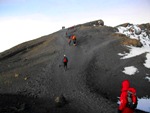

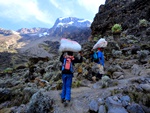
Day 1). Machame Camp
Day 2). Shira Camp
Day 3). Barranco Camp
Day 4). Karanga Camp
After a good nights sleep, you will be up at 6am for 7am breakfast. We have amazing challenge for you today! We head up the Barranco Wall, check out our You Tube video on the wall. This can take a couple of hours to reach the top at 4,200m/ 13,780 feet. Upon reaching the top, we take a break right under the summit in the distance. Then, you will continue on easy trails up and down as we cross Kilimanjaro to the Karanga Valley. Then with the camp in view across the Valley, we drop steeply down 140m/ 460 feet, before coming back up 120m/ 400 feet to the Karanga Camp at 4,050m/ 13,287 feet. This will take approximately 4 hours today and the total distance is 5.6km/ 3.5 miles.
Day 5). Kosovo Camp
Today starts the business end of the trek, as you head up to your high camp. You will leave at 8am and take our time, walking very slowly and saving all our energy for the final climb. You will take lots of breaks on the section and continue to cross around Kilimanjaro before a final steep section to Barafu Camp at 4,650m/ 15,256 feet. This is where most people stay before their ascent of Kilimanjaro. We move through Barafu Camp and hike an additional hour further to Kosovo Camp at 4,900m/ 16,076 feet.
The walk to Barafu Camp is approximately 3 hours and then another hour to Kosovo Camp, so a total of 4 hours today. The goal will be to be there for a big lunch/ dinner around 2pm. We encourage you to rest after the meal as you will get up at 11:30pm to prepare for your summit bid. Today you will walk 3.5km/ 2.2 miles.
Day 6). Summit to Mweka Camp
You will wake up at 11:30pm for a 12:45am departure from Kosovo Camp. However, this will depend on the conditions, size of the group and a range of other factors. You should start drinking water (a liter if possible), start eating some food in your tent,and prepare to leave. Remember, tonight is not easy, so when you are mentally struggling you need to remember to breath deeply.
It normally takes about 6 hours from Kosovo Camp to the summit. The last 2 hours to the Carter Rim will test you, so stay focused and believe you can do it as you are almost there. From Stella Point at the carter rim it is one hour to the summit on easier terrain. Then, you have reached the Roof of Africa!
From the summit back to Kosovo Camp can take 2-3 hours. You will have a chance to rest for a few hours and pack up your duffel bag before having lunch and moving down lower. You will head down to Mweka Camp at 3,100m/ 10,170 feet. This will take 4 hours down hill. Finally, the long day will come to an end! The full day is between 12 – 14 hours of trekking and covers 18.1km/ 11.2 miles.
Day 7). Mweka Gate
After an amazing nights sleep in Mweka Camp, we will have a quality breakfast before saying goodbye to our world class Kilimanjaro crew. However, our head guide, who is Kilimanjaro’s Number one Guide, and assistant guides will stay with you all the way until the end. From Mweka Camp to the Mweka Gate takes approximately 3 hours, walking back through the Rain Forest. Without a doubt, you will want to use your trekking poles to save your knees for the way down from the summit of Kilimanjaro to the gate.
Once you get to the exit gate, you will sign out from the National Park and jump in the bus. The team will drive a few minutes down the road to have lunch. After lunch, you will get back in the bus and then drive back to our hotel in Arusha. Today is 9.3km/ 5.8 miles.
Speak to the Experts
Hopefully this helps you understand the daily distances you will have to travel on the Machame Route up Kilimanjaro. GET IN TOUCH today for more information on our Kilimanjaro Climbs. We want to make sure that our clients have all the right information to help them prepare for the journey ahead. If you want to have an safe and successful experience on the mountain, then get in touch today!
No matter what, the summit night on Mount Kilimanjaro will be a challenge! All of our 8 day trips on Kilimanjaro start the summit night from Kosovo Camp 4,900m/ 16,076 feet. Normally, trips leave from Barafu Camp 4,650m/ 15,256 feet. Kosovo Camp gives our clients the best chance of success. We are getting 100% on most of our 8 day Lemosho Route trips.
Everything Comes Down to Summit Night
Barafu Camp sits at 4,650m/ 15,256 feet and Kosovo camp is at 4,900m/ 16,076 feet. Your Kilimanjaro climb will come down to one long summit night and day. If you are leaving from Barafu Camp, you will likely leave around midnight, and if you are leaving from Kosovo Camp, you will leave around 1am. No matter where you leave from, it is a long, slow and mental challenge to reach the summit of Kilimanjaro at 5,895m/ 19,341 feet.
Our Approach to Summit Night on Kilimanjaro
After 17 years of climbing on Kilimanjaro we have developed the best approach to summit night to maximize safety and success. If weather allows and winds are low, we will be taking off from the higher camp of Kosovo. The reason that our teams can do this is because we have taken adequate time to acclimatize lower down on the Shira Plateau. If you are only on a 5-7 day trip, it can be risky going all the way to Kosovo Camp for the night. The reason for this is that your body would not be able to cope with the altitude with less acclimatization.
Our teams aim to reach Barafu camp at 11:00am or Kosovo camp at 12 mid day. Indeed, this will give our bodies the time for additional acclimatization and most importantly rest and sleep. By staying at the higher camp, we will also position ourselves away from the noise of the main camp. Review the elevation gains.
Kilimanjaro’s Number 1 Guide
At approximately 11pm it will be time to get up and to start getting dressed and your gear ready. It is important to start slowly drinking water. The goal would be to try and drink 2 liters of water before you leave on the summit night. At 12:15am we will be served breakfast in the dining tent and you can fill your Nalgene bottles with boiled water for the night ahead. Some people like to have 2 Nalgene bottles (2 liters of water) for their summit attempt. This is a personal choice on how much you carry. Make sure you keep well hydrated during the whole trip and even prior to joining the Kilimanjaro climb. Our Head Guide is Kilimanjaro’s Number 1 Guide so you will be in good hands.
Start Hiking to the Summit of Kilimanjaro
At 1am, we will start hiking towards the summit. We will aim to gain 200m/ 656 vertical feet, per hour on route to the summit. Our goal on the summit night is to keep a very strict routine while going up. We will walk for an hour and then stop, drink water, eat some snacks and go to the toilet just off the trail. Each stop will be 5 to 7 minutes, depending on the weather. We will repeat this for the next 5 hours as we slowly edge our way above 5,500m/ 18,000 feet. As we reach this elevation we may need to stop every 30 minutes as the lack of oxygen becomes more challenging. At this stage, we will begin to slowly move towards Stella Point, as light hits the horizon.
Steep Terrain up and down
The last section up to Stella point is one of the hardest during the night. The pace will be slow and steady as you focus on deep breathing. Once we get to Stella Point, it will likely be very cold, so we will rest for 5 minutes and have some hot tea. Then, we will continue the 50 minutes to the true summit. The terrain is now a little easier than the previous hours to reach Stella Point. The lack of oxygen is challenging, so you need to make sure you are focusing on deep breathing all the way up to the summit. Getting oxygen into your body is the most important thing you should be thinking abouton your summit attempt. After 6/7 hours of walking up hill you will reach the summit of Kilimanjaro!
Standing on the Summit of Kilimanjaro
Enjoy the achievement of reaching the summit of Mount Kilimanjaro!! You will have dreamt of this moment for months even years. Savor the moment, as it will stay with you for the rest of your life. After the struggle and challenge to reach the summit is over, remember you are only half way. The descent is steep and takes a lot of focus as the terrain is challenging under foot.
The Steep Descent
Next, we will begin to move as a team back to high camp, which should take about 3 hours. It is extremely important to get back down below 5,500m/ 18,000 feet as quickly as possible. Depending on what time we reach high camp, you will have some time to rest, re-hydrate, eat a full lunch, pack your bag and slowly make your way down the trail. We will make our way all the way down to Mweka Camp at 3,100m/ 10,171 feet. From the summit, this is a 2,795m/ 9,170 feet drop down to the camp! This WILL likely be one of the most challenging days of your life to cover this distance!
Pick 8 Days on the Lemosho Route
We highly recommend our 8 day climbs as you want to give yourself the best and safest chance at trekking to 5,895m/ 19,341ft. Watch the video above to see some raw footage from the summit night on Kilimanjaro. Read some REVIEWS from our trips.
Lack of Physical Preparation is Risking Safety
Ian has climbed Kilimanjaro over 37+ times now. From his experiences on the mountain, the place he sees clients struggle the most is on the final two hours to the Crater Rim. Usually because people never train doing long 5+ weekly hikes, building up their endurance.
You need to keep moving because of the cold, and the pace will be super slow. Therefore, you will be able to take your time the team can take multiple short stops at this stage. It is now a mental game and you have to believe in yourself and dig deep. Most of the hard work is done. Dig deep, breath deep and you can make it to the top. Read our training advice.
Sleeping Lower Aids in your Recovery
After you have enjoyed the summit of Kilimanjaro, you will then need to drop down out of this extreme altitude. As we said above, it will take approximately 3 hours to get back to high camp. After the break in high camp, you will pack up and have approximately a further 3/4 hours to Mweka Camp at 3,100m/ 10,170 feet. You will be back in the rain forest and now you can celebrate you summit success. This can be a 12/14 hour day in total, and can be very difficult! Therefore, you need the best acclimatization in the lead up to this challenging summit night climb on Kilimanjaro. CLICK HERE for more information on our climbs.
Contact The Experts
GET IN TOUCH today for more information on our climbs of Kilimanjaro! We have helped over 3,000 to the summit. We want to help you reach your goal of standing on the Roof of Africa! If you want to be successful on Kilimanjaro, then check this link out with all you need to know about climbing Kilimanjaro.
There are two factors that will determine the elevation gains on your Kilimanjaro trip: what route you choose to take and how many days you will do it in. After helping over 2,500 people in the summit of Kilimanjaro, we really only use the Lemosho route over 8 days on the mountain as this route gives us a 95% success rate. Our itinerary will give you the best chance of reaching your goal of the Roof of Africa, while also allowing you to enjoy the journey.
Daily Elevation Gains on the Lemosho Route
We will showcase the elevation gains on the Lemosho Route up Kilimanjaro. However, if you chose less days, you are going to see far higher jumps in altitude. This will make a big difference in your acclimatization and safety. Why not join one of our upcoming trips and climb with Kilimanjaro’s Number 1 Guide. We will make sure you have the tools to make a safe and successful attempt on Kilimanjaro.
Day 1). Arusha – The gateway to safari and Kilimanjaro
You will arrive at Kilimanjaro International Airport and we will transfer you to your hotel in Arusha. We use the Karama Lodge or similar in Arusha. You might not think it but you already started your acclimatization on your flight. The cabin pressure on your flight would normally be set around 2,000m/ 6,561 feet. Then, you will continue your acclimatization in Arusha as it sits at 1,400m/ 4,593 feet. At this elevation, there is 12% less oxygen than at sea level.
Remember, you can always come in early, recover from jet lag, time zone changes and gain extra acclimatization for the climb. Depending on where in the world you live, you may need more time than just one night in Arusha. We have people joining our climbs from around the world. It is important so make sure you are rested and well hydratedbefore you start the climb, in order to start off on the right foot.
Day 2). 3 Hour Drive to the Londrossi Gate and 3 Hours Hiking
You will be up early for breakfast as the goal is to leave by 8 am for the three and a half hour drive to the Londrossi Gate. The Gate sits at 2,250m/ 7,381 feet. On our climbs you will have a full 3 course meal for lunch at the gate before you get back into the vehicle for 25 minute drive to the start of the trail. The start of the trail is at 2,300m/ 7,545 feet. After trekking for 3 hours you will then reach Big Tree Camp at 2,800m/ 9,186 feet. You are now at high altitude, therefore, it is important to take your time with everything you do. You will hiking up 500m/ 1,640 feet and covering 3.9 miles/ 6.2km on this day. Watch video from Day 1 on the Lemosho route.
Day 3). The Journey up to the Shira Plateau
Breakfast will be served at 7 am. Your bags will need to be packed and ready, so tents can be dismantled and moved to the next camp, Shira Camp 1, at 3,500m/ 11,500 feet. At 8 am you will be moving, hiking through the rain forest. Once you hit 3,000m/ 9,842 feet, you will exit the rain forest, and the route up to the Shira Plateau reveals itself. Today, you cover 700m/ 2,296 feet over 5.7 miles/ 9.1km. Watch video from Day 2 on the Lemosho route.
Day 4). Moving Across the Shira Plateau
Today is an easier hike, but you are still at high altitude and therefore you still need to be drinking 4 to 5 liters of water. The route today leads across the Shira plateau to Shira Camp 2 at 3,900m/ 12,795 feet. Once you arrive at Shira Camp 2 you will have lunch and then continue up to 4,000m/ 13,123 feet for additional acclimatization. After this acclimatization hike, then you will return for the evening in Shira Camp 2. Today, you will cover 500m/ 1,640 feet for ascent and 100m/ 328 feet of descent, over a distance of 6.2 miles/ 10km. Watch video from Day 3 on the Lemosho route.
Day 5). The Critical Acclimatization Day
Today is one of the big acclimatization days. You will need to leave camp at 8am for the 4 hour hike up to the Lava Tower at 4,640m/ 15,091 feet. Our team will have the mess tent erected at the lava tower for you to rest in the shade and be served a three course meal. After lunch, then you will descend all the way down to Baranco Camp, at 3,900m/ 12,795 feet. This is a long day where you hike up 740m/ 2,428 feet and also down 740m/ 2,428 feet and cover 6.7 miles/ 10.8km. Watch video from Day 4 on the Lemosho route.
Day 6). The Barranco Wall to the Karanga Camp
After a good nights rest, then you will be right back at it! For many trekkers, today is a favorite day, as you climb up and over the Baranco Wall. We think that the Baranco Valley is the most beautiful valley on Kilimanjaro. This is an easier day and the Baranco Wall should not scare you. Most people are ready to do it again after they complete it as they have so much fun scrambling through the rock in the amazing and unique place.
The elevation gain on the Baranco Wall is 300m/ 984 feet. Once on top of the wall, you make a series of ups and downs before dropping 140m/ 460 feet, into the Karanga Valley. From there, you will continue moving back up the trail another 120m/ 400 feet, before arriving at the Karanga Camp at 4,050m/ 13,287 feet. The total amount of elevation gain today is 450m/ 1,476 feet. Also, the descent is a total of 220m/ 721 feet. Therefore, you will cover a distance of 3.5 miles/ 5.6km today. Watch video from Day 5 on the Lemosho route.
Day 7). High Camp and Launching Pad for the Summit
Today the team will move up to one of two points: Barafu High Camp at 4,650m/ 15,255 feet or Kosovo Camp 4,900m/ 16,076 feet. The goal is always to get to the Kosovo Camp, however this is weather dependent. This is putting you in to the best position for the early morning hours for your summit attempt. The goal is to get to high camp early to aid in the acclimatization process.
Once you reach high camp, then you will be served a full three course meal. Then you will have time to get your clothing ready for the summit attempt before trying to get as much rest and sleep as possible. You will be up again at 11pm, preparing for the push to the summit. There is no down hill today, therefore, you will just go uphill 650m/ 2,132 feet or 900m/ 2,953 feet if we go up to Kosovo Camp. Aiming to arrive into high camp around mid day. You will cover 2.7 miles/ 4.3km today, getting into high camp. Watch video from Day 6 on the Lemosho route.
Day 8). One of the Biggest Trekking Days of your Life
This is it, all that you have been preparing for over the past year or more! Today is your summit night , with a full day of hiking up and down the mountain. Summit day is approximately a fourteen hour journey. You will travel up to the summit 1,245m/ 4,084 feet or 1,095m/ 3,592 feet if we leave from Kosovo Camp, and then drop down 2,795m/ 9,170 feet. This is a VERY tough day, even for the most seasoned trekker! Therefore, you MUST be prepared!
After reaching the summit and heading back down to the camp, then you will get a two hour break. There, you will have time for a full lunch, some rest and time to pack up your bags. Then, you will be moving down to Mweka Camp, at 3,100m/ 10,170 feet. On this very long day, you will cover a distance of 11.2 miles/ 18.1km. Watch video from Day 7 on the Lemosho route.
Day 9). The Rewarding Walk Down Kilimanjaro
After an amazing nights sleep at lower altitude, then you will begin your final day on the mountain. Today, you will drop from Mweka Camp at 3,100m/ 10,170 feet, down to the Mweka Gate at 1,700m/ 6,233 feet. This is a beautiful walk, down hill through the rain forest. However, your legs will be tired from the day before! You will descend down 1,400m/ 4,593 feet today and will cover a total distance of 5.8 miles/ 9.3km. Watch video from Day 8 on the Lemosho route.
If you want more information or to start planning your trip up Kilimanjaro, then GET IN TOUCH today! We have the expert information you need to make your trip a success. Likewise, we have the team in place to give you the best experience in reaching Africa’s Highest Point!
The Best way to Train for Downhill
Not everyone will have access to hills, but this is the best way to train your body and legs for down hill hiking. Depending on your chosen adventure you do need to assess the level of downhill. We have elevation gains available for all of our key trips. I encourage you to review the daily elevation drops and what type of terrain you will be walking on.
For example, on our Inca trail treks you will be drop 700m/ 2,296 feet to 1,000m/ 3,280 feet on different days all on steep rocky stairs. On Kilimanjaro you will drop 2,800m/ 9,186 feet in one day on scree and rock and this is very challenging on your legs and joints.
You have just walked for days on end you have reached your goal but not you have to retrace your steps, often in a quicker time frame. Hiking downhill will take its toll on your joints. Fore sure, the downhill hike will take more wear and tear on your joints and muscles than the uphill.
You do need to use effective training techniques to minimize the impact on your body. Descending using good technique means that you move faster and feel lighter. Remember, 80% of accidents happen on the way down.
Keeping Knees Healthy
We live in Eagle-vail Colorado with amazing access to altitude and a wide range of mountain terrain to train on. In Colorado we can train all year round on hilly terrain preparing for Kilimanjaro, Himalayan trekking and mountaineering trips. I know most of you are joining our trips from sea level and with minimal access to hill training. I encourage you to get out to Colorado doing some multi-day hiking in preparation for your chosen adventure.
If you do not have access to hills and mountains, you must figure out other ways to prepare your knee joints to handle downhill stress. From a knee perspective, downhill hiking means eccentric loading and typically thousands of repetitions of it. Eccentric loading (the lengthening phase of a contraction) is especially challenging to what is called the patellofemoral joint of the knee. This is where the knee cap, meets the femur. Inadequate strength, poor mechanics and lack of exposure to this type of loading can turn downhill forces into injury producing stress. Prior to your trekking trip you need to start implementing sport specific training into our general preparedness programming.
Hiking Uphill and Downhill
Hiking uphill is all concentric muscle action (muscle active while shortening) at the knee joint without any eccentric loading (loading while muscle is lengthening). Concentric only exercises tend to cause less mechanical stress, load and pain to joints and tendons than do exercises that have eccentric phases. What goes up must come down.
You must prepare our body and specifically your knees to handle downhill hiking. Depending on the trip, you really need 6 months of some sport specific training into our general preparedness programming.
The strength movements below are similar but slightly different in specific ways. We purposely only hit each one once per week because too much volume of these exercises could quickly lead to an over training injury, so be careful. I would recommend adding in additional hip flexor and quadriceps mobility work at the end of your training sessions as well to maintain good length tension relationships and to protect your spine.
The Point of These Exercises
Increase vertical loading volume of the knees with a sight posterior to anterior (back to front) force vector. Get exposed and accustomed to decelerating the vertical and forward forces using primarily a knee strategy. Transition from doing most lunges and squats with a 3 points of contact foot position to a more heel elevated position where we contact and press through the forefoot.
The 3 points of contact foot position is the most stable position for the foot and encourages a balance of hip and thigh musculature – great for general preparedness training. Transitioning to a heels elevated position where the forces are applied through the forefoot places most of the stress on the quadriceps and knees – optimal for downhill hiking training.
Exercises for Downhill Hiking
You should consider adding these movements into your weekly training 2 times per week. Add 3-5 sets of 10-15 repetitions (per leg)
1). Heels Elevated Goblet Squat
2). Forward Alternating Lunge with Farmers Carry Loading
3). Forward Alternating Drop from Box Lunges
4). Banded Posterior to Anterior (PA) Forward Lunges
Carrying Weight
One of the best ways of mitigating the risk of musculoskeletal issues is by carrying a light pack. Then build up the weight you carry over time. An overly heavy backpack is not recommended in the early stages of your training.
Extract its biggest toll on your body during steep and/or long downhill sections, so a hiker should always aim to travel as lightly as the dictates of their skillset and the environment into which they are venturing allow.
If you are carrying weight on longer hike you should slowly build up the weight you carry. You should also consider carry water uphill and dump as much water/ weight as possible for your downhill. Always assess the weight you are carrying for each hike and always build up slowly over time. You do not want to get injured.
Tips for Hiking Downhill
1). Do not have your trekking boots too tight on the way uphill. Most certainly keep your boots tight for the downhill portions of your hike/ trek. Not so tight that they restrict blood flow.
2). Tighten your hip belt and shoulder straps – on steep and uneven descents this will assist in minimizing pack movement, which can impede your balance if left unchecked.
3). If you’re carrying trekking poles, lengthen them accordingly. Poles that are too low will have you reaching unnecessarily forward, thereby disrupting your center of gravity.
4). On big downhill’s like Kilimanjaro, Don’t forget to trim those toenails.
5). Don’t lean forward, don’t lean back – while descending a mountain your center of gravity should be low and over your legs.
Learning from High Altitude Guides
I have trekked to Everest Base Camp over 40 times, Kilimanjaro 40 plus times and have watched some local guides move very efficiently downhill. They effortlessly make their way along rugged, steep and rocky trails. They keep a low center of gravity, the way they bend their knees, they shortened their stride. Taking baby steps, they flow rather than hike down the mountains trails.
Minimize Weight Bearing Impact While Descending
Gravity is not your friend when it comes to downhill hiking. Hiking downhill takes significantly more toll on our bodies than other types of walking. Increased moment and knee flexion angle yield a 3 to 4 times bigger femoropatellar joint compressive force for downhill walking compared to level walking,
You can start by always keeping your downhill leg slightly bent on impact. This will help minimize stress on the knees, as the muscles rather than the joints take the brunt of the strain. Slowing down for steep steps, turn your body sideways and lower your weight down steep terrain is also using on steep steps and steep terrain.
Use Trekking Poles
Poles can help by redistributing some of the load to your arms and shoulders, thereby reducing strain on the lower body. As a bonus, poles can also assist with balance and stability by providing two extra points of contact with the trail; particularly helpful for folks that aren’t especially surefooted and/or have pre-existing leg issues. Trekking poles are great on the Inca trail stairs, Everest trail, Aconcagua and pretty much every steep downhill.
When the gradient is steep like on Kilimanjaro, taking smaller steps will help to keep your center of gravity over your legs, thereby promoting greater balance and control.
Pay extra attention to where you are placing your feet. Most accidents, slips and falls occur on downhill stretches that immediately follow long ascents. After the exertion of the climb, it is extremely important to remain focused on the descent.
Build up to Longer Hikes Carrying More Weight
The reason to carry weight in your backpack is to stress test your overall strength and conditioning for multi-day trekking. Building strength in the appropriate muscles for hiking up and down hill. By diligently practicing good technique, over time the speed and confidence with which you descend will increase and allow you to physically be able to carry more weight which will build your overall strength for trekking.
Be Careful Descending Snow Slopes
How you descend on a glacier or snowy terrain is dependent upon the condition of the snow and the gradient of the slope. A commonly used technique is the plunge step. Landing heel first, let the weight of your body drive your foot into the snow.
The harder the snow, the more aggressive the effort needs to be. Keep your knees slightly bent to avoid hyperextension. When descending steep snow slopes, reduce the gradient by zigzagging across the terrain. Make sure all of your gear is stored inside your backpack or safely secured.
Patience is your friend. If the snow is simply too solid you need to revert to side stepping and taking smaller steps as you manage your moving downhill.
Descending Scree Slopes
Take your time, Monitor your momentum and be careful of big rocks underneath the surface. This is a big deal descending Kilimanjaro, care is needed when descending on scree and loose rock. Take short, controlled steps. Keep your center of gravity over your legs at all times.
If there is someone below you, be sure to give them plenty of space, in case you accidentally trip, dislodge a largish rock or can not control your balance. Once you have the necessary techniques down pat, stay as loose as possible. Think flow. Move with the terrain, rather than against it.
Our Unique Itinerary
Day 1 - Arrive at Kilimanjaro International Airport
You should aim to arrive as early as possible this day or you are welcome to arrive in earlier if you choose. Once you arrive, you will be picked up from the airport and taken on a 50-minute transfer to the hotel in Arusha, where you will be booked on a shared bed and breakfast basis. You will have a group briefing in the evening with our head guide to prepare you for the journey ahead. Our head guide was named the Mountain Guide of the year in 2019 on Kilimanjaro and you can read more about him here: https://iantaylortrekking.com/blog/kilimanjaro-mountain-guide-of-the-year-2019/
Day 2 - Londorossi Gate to Mti Mkubwa (9,186ft / 2,800m)
After breakfast at the hotel, our local team will be there to pick the team up to start the journey! Normally, the meeting time will be 8am, but this will be confirmed at the briefing the night prior. A three-hour drive from Arusha takes us to the Londorossi Park Gate, located on the western side of Kilimanjaro, where we should arrive by midday, to register at the gate and enter the Kilimanjaro Park, this process can take up to a couple of hours. While we wait, we will have our lunch at the gate and sign in to the National Park. Here you will begin to realize that we are on one of the least trodden routes compared to the "standard" lines of ascent such as Machame and Marangu. The flora and fauna are richer here and in places the vegetation is so untouched that it grows right across the narrow track. Our trek today will be along a little used track known as Chamber's Route. In approximately three hours, we will reach our camp in the forest at Mti Mkubwa, otherwise known as Big Tree Camp, at 2,800m/9,186ft.
Day 3 - Mti Mkubwa to Shira One Camp (11,480ft / 3,500m)
After breakfast, we start the climb through the rainforest towards the giant moorland zone. Today is a full day's trek with a significant gain in height. So it will be tough, even at a relatively low altitude. We will take a lunch stop at the crest of a ridge, just below the Shira Crater at approximately 3,000m/9,850ft. After lunch, we follow the ridgeline steadily upwards towards the Shira Caldera, a high altitude desert plateau, which is rarely visited. Shira is the third of Kilimanjaro's volcanic cones, and is filled with lava flow from Kibo Peak. The crater rim has been massively eroded over time by weather and volcanic action. Today we'll get our first close views of Kibo - the central volcanic cone and literally "the Roof of Africa". The second of the 3 volcanic spouts that make up Kilimanjaro is Mawenzi, but this lies hidden for the time being to the east of Kibo. Today’s walk will be approximately 6 hours before reaching the
camp at 3,500m/11,480ft.
Day 4 - Shira One Camp to Shira Two Camp (12,795 ft / 3,900m)
After breakfast, we continue to hike east across the Shira Plateau past the Shira Cathedral (12,470ft / 3,880 m), towards Shira Two camp. The views of the plateau, across the mountain and to the plains below are nothing less than spectacular. After lunch we will hike up to 4,000m/13,123 ft. for some additional acclimatization.
Day 5 - Shira Two Camp to Baranco Camp (12,795 ft / 3,900 m)
Today is a tough seven-hour hike in superb country. We start the day before lunch in a steady uphill ascent towards the Lava Tower. Today, we will focus on a similar pattern/pace that will happen on the summit night. Once we reach the Lava Tower at 4,640m/15,223ft, we will stop for a hot lunch and rest before we slowly descend to Baranco, our most spectacular campsite, situated at the foot of the Kibo Peak. As we travel, we will look up to the hanging cliff of the Breach Wall, which has given the likes of Messner some extremely hard climbing – when he took a new route up a hanging icicle draped from the top of the wall. As we descend to Baranco, the southern ice-fields will come more clearly into view. Sleeping at a similar height as we did the night before, gives excellent acclimatization after reaching a new height record for the trip at the Lava Tower. Today we will be hiking for approximately 7 hours and will be a challenging but rewarding day.
Day 6 - Baranco Camp to Karanga Camp (13,300ft / 4,050m)
After breakfast, our first challenge is to overcome the Baranco Wall, which is
300m/984ft high and takes us to an altitude of 4,244m/13,924ft. The Baranco Wall will look daunting from the camp, however it is definitely less difficult than it looks! It looks as if it is a steep path, however the path which we take, winds its way up the wall and never feels exposed or dangerous. There are short sections of easy scrambling, which are fun and quickly overcome. From the top, the receding Heim Glacier on Kilimanjaro's south face is clearly visible. The route then continues eastwards underneath the Decken and Rebman Glaciers to the Karanga Camp (4050m/13,287ft), which is situated above the Karanga Valley. Today will be a fun four to five-hour trek to the Karanga Camp at (4,050m/13,300ft).
Day 7 - Karanga Camp to Kosovo Camp (16,010ft / 4,880m)
Today is another reason that we are different from other trips! From Karanga camp, we will head steadily upward to the high camp of Kosovo, which will give our teams a better chance of reaching the summit. A 4-hour steady walk takes us to Kosovo Camp (4,900m/16,010ft) from where we will set up to make our summit attempt. This is a short day, but included to give some essential pre-summit acclimatisation, without being too physically exhausting. The air is noticeably thin now, and you will be running short of breath as you climb out of the Karanga Valley. It is a slow tough hike up to the Kosovo Camp and we will be moving extremely slow as a group as we pass Barafu camp, where most other teams will be stopping for the day. On arrival, we begin to get ourselves ready for our summit attempt. This means preparing all our gear and water for the push up to the top, as well as getting as much to eat and drink as possible, and going to bed very early. We will wake at 11/ 11:30pm to prepare for
our summit attempt! If the weather is not in our favour, and it is too windy at the
Kosovo Camp, we may have to stay a bit lower at the Barafu Camp at (15,250ft/4,650m), but our goal will always be to reach Kosovo Camp!
Day 8 - Kosovo Camp to Uhuru Peak (19,340 ft / 5,896m) to Mweka Camp
When we wake up at 11/11:30pm in the Kosovo Camp, we will get ourselves dressed in all of our warmest summit gear as we will begin walking well before dawn, and the coldest part of the day comes just before sunrise. This summit day proves to be the steepest and most demanding part of the mountain, and we will be taking it very slowly as we move up the trail. The moon may provide some light, but we'll be using head-torches for several hours until the sun rises. We will aim to reach Stella Point on the Crater Rim by sunrise after approximately 5 hours of constant up-hill walking. At dawn, from the Crater rim, rugged Mawenzi is a thrilling sight, with the Kibo saddle still in darkness beneath you, and the crater's ice-walls looming ahead. From Stella Point, we turn left, and continue along a good path for approximately one hour more, cresting the top of the crater, until we reach Uhuru Peak, the summit of Kilimanjaro! The crater wall stands steeply over the crater floor about 200 feet below us to our right. As the sun rises, light hits the crater floor, illuminating the Furtwangler Glacier and the warmth of the sun will be a welcomed feeling! This will be by far the toughest day you will have on the trek and the views from the summit will make you realize why you decided to put yourself through the pain! After about thirty minutes or so on the summit, we will begin the long slog back down to the camp on the same trail we came in on. It will take us approximately 2 to 3 hours walking before we arrive back at the camp, and you will be welcomed with tea and brunch and a quick rest before we continue our way down the mountain. We will have another 4 hours of walking from Kosovo camp to reach our final destination of the night, Mweka Camp.
Having started this extraordinary day out as early as mid-night, and not finishing the day until the sun is setting, you can imagine how exhausted your body will be as you rest in celebration of your success on the highest point in Africa!
Day 9 - Mweka Hut to Mweka Gate to Arusha
We will wake early in the morning today to begin our final walk off of Kilimanjaro. The walk today will take us approximately 3 hours to get from the Camp to the Mweka gate. When we arrive at the gate, we will say ‘kwaheri’ or goodbye to our porters and take a short 5-minute ride in the vehicle to our final lunch spot, where you will also have a chance to do a little souvenir shopping before getting back in the vehicle for the two-and-a-half-hour journey back to Arusha. Here you will get to enjoy a well-deserved shower and bed to sleep in!
Day 10 - Arusha
Today will be spent at leisure in Arusha. You can decide to sit by the pool at the hotel or exploring the town of Arusha. We will transfer you back to the airport to catch your international flight home. There is also an option for you to stay on in Tanzania and do one of our Safari options, sampling some of the world’s most unique wildlife: https://iantaylortrekking.com/trek-africa/safari-in-tanzania/.
Equipment
1). La Sportiva Trango Tech GTX
In our opinion, La Sportiva have great footwear options at the moment. Finding a boot that will last a long time, be comfortable, waterproof and have good support, is always our goal. This option is both a great trekking boot as well as a light mountaineering boot for alpine climbs. They are crampon compatible, however still a lightweight option good for a Kilimanjaro climb. Having the slightly more rigid sole helps keep your foot sturdy and protected on the trails on Kilimanjaro. They will also be a warm option for the cold night spent going up to the summit! These boots would be a great option for the trekking portions on Mount Elbrus or Aconcagua as well.
2). Salomon Quest 4 GTX
Another great option is the Salomon Quest 4 GTX Trekking boots. More and more people are using these trekking boots on a wide range of our trekking adventures in Nepal and around the world. They are comfortable, sturdy, waterproof and a very resilient trekking boot. They will give you the warmth you need on the cold night walking to the summit as well! We would recommend these boots for Everest Base Camp, Aconcagua, Mount Elbrus, and a range of other treks.
3). Scarpa Kenesis
Ian has used the Scarpa Kenesis pro GTX trekking boots for a few years. They are a little heavier than other trekking boots but a great boot for Kilimanjaro. If you maintain them well, you will have them for years. Scarpa are always re-inventing trekking boots and if they fit your foot correctly, then they may be the right boot for you. They work great and last a long time.
4). Mammut Trovat
Ian has also used a range of Mammut trekking boots over the years. He really likes the Mammut Trovat guide High trekking boots. They are really durable, reliable and will last a long time. The high ankle support is great for the rocky terrains you will encounter and all around a great boot for Kilimanjaro. All these boots will last a long time if you look after them well.
5). Meindl Vakuum
You could also consider using the Meindl Vakuum trekking boots for your Kilimanjaro climb. These are also a good option a wide range of trekking peaks and multi-day trekking adventures. These are a very popular boot and we see a lot of clients arriving to Tanzania in this option. They are an excellent choice for mixed rocky terrain and long distance hiking. These boots will be with you for many miles as they are an extremely durable boot. Also, this could be a good option for you if you feel the cold in your feet as they will be a warmer option.
Some of the Boots we Recommend
These are just some of the boots we have used and recommend. Just so you know all of these boots will work on every trekking trip we offer. They are great for Everest Base Camp Treks and walking into Mera peak, Island peak, Elbrus, Aconcagua or any trekking trip that we offer. All of these boots also come in Men’s or Women’s styles. Therefore, they should work for anyone coming on one of our Kilimanjaro trips!
Once you have signed up to one of our Kilimanjaro climbs, then we will send you our 40 page trip Dossier. The Dossier includes an itemized kit list, training advice and other relevant information to help you come fully prepared to Tanzania. We want you to have a safe and successful journey, therefore we want to make sure you have all the correct information. We have Kilimanjaro’s Number one Guide leading our teams on the ground in Tanzania. Here is our packing video, showing you what items Ian will bring on his next Kilimanjaro climb.
Chat With the Experts
We are your best resource for getting the right gear for your climb of Kilimanjaro and will be available to you 5 days a week to assist you. If you want to have the best experience on Kilimanjaro, then GET IN TOUCH today. Please feel free to contact us anytime at info@iantaylortrekking.com to set up a time to discuss your gear. If you would like to learn more about climbing Kilimanjaro continue reading.
FAQ'S
Q). Is it difficult to climb Kilimanjaro?
A). The question how difficult is it to climb Mount Kilimanjaro is a very tough one to answer! If you are used to hiking long distances weekly covering 1,000m/ 3,280 feet, carrying your backpack with weight. Along with, training 5 days a week and in good physical conditioning. You might find it straight forward. Also you have 8 days on the mountain, this gives added acclimatization and safety. We use Kosovo Camp at 4,900m/ 16,076 feet which helps on the long and challenging summit night. Learn more.
Q). What are the best months to trek Mount Kilimanjaro?
A). Traditionally, the weather on Mount Kilimanjaro is fairly predictable. Kilimanjaro has dry seasons and rainy seasons. Some months have more sun, some months have to more cloud cover and other months are colder than others higher on the mountain. We highly recommend January, February, June, July, August, September, October and we like a New Year trip from December into January. Learn more.
Q). How difficult is the Barranco wall?
A). A lot of people have fears when it comes to the Barranco Wall. However, the truth about the Barranco wall is that 95% of this infamous place on Kilimanjaro is just slow walking. There are just a couple of scrambling sections on the lower and upper most part of the wall. They do not require any technical experience, just a bit of extra focus, good balance and core stability. Learn more.
Q). What will the food be like on Kilimanjaro?
A). Every company is different. We only run Kilimanjaro tours to the high quality. We only serve hot meals each day with 3, 3 courses meals a day on Kilimanjaro. Learn more.
Q). How much is the visa fee to enter Tanzania?
A). Right now the visa fee ranges from USD $50 to $100. For US clients it is $100, while most European countries will pay $50.
Q). What vaccinations do I need to enter Tanzania?
A). Tanzania does NOT have Yellow Fever in the country, so they only require you to show proof of vaccine for Yellow Fever if you are from a country that does have Yellow Fever. Or transiting for more than 12 hours in an airport located in a country with risk of Yellow Fever Virus transmission. Here are some recommended for vaccinations entering Tanzania: Tetanus, Hepatitis A, Typhoid, Hepatitis B, Poliomyelitis, Cholera, covid19 and tablets to protect you from getting malaria. Learn more.
Q). How much does it cost to climb Kilimanjaro?
A). After putting over 3,000 people on the summit we have developed a quality system and unique itinerary for a successful Kilimanjaro Summit. If you want to give yourself the best chance of success you will be paying $400 to $500 per day to have 35+ quality staff, quality tents, equipment, safety equipment, quality food and all the systems in place. So, for a 7 day Machame route tour you will pay anywhere from $2,300 to $4,000 including airport pick up and drop off and hotel nights on either side of the trip. For a 8 day Lemosho route climb you will pay anywhere from $2,700 to $4,500 depending on the hotels, service the company offers prior to the climb. If you have a western guide it can cost even more. Remember 8 days on the mountain gives you the best and safest chance of standing on the summit. Learn more.
Q). What additional expenses will I incur?
A). Here are some additional expenses that you will incur. Visa Entry, meals in Arusha, Tips, laundry, souvenirs, insurance, helicopter evacuation cover.
Q). How much should I tip the staff and can I give individual tip for the porter who carried by backpack?
A). We recommend tipping the staff as a group on the last morning of the trip in Mweaka Camp before descending to the gate. The tips can be given to Athumani or Head Guide and they will distribute to the Dream Team. We recommend $300.
Q). What insurance do I need to have?
A). We recommend having Global Rescue Helicopter evacuation along with their or any insurance that covers trip cancellation cover, repatriation along with medical expenses.
Q). What challenges will I face climbing Kilimanjaro?
A). You will possibly experience rain, wind, hot, cold temperatures all in one week. High UV levels from the sun, so stay covered up. The higher realm of Kilimanjaro sits in Extreme altitude. The biggest summit day of your life! Going up 1,000m/ 3,280 feet from Kosovo Camp to the summit and back down to Mweka Camp. Possible physical fatigue, depending on physical preparation. You will not sleep as well as you would at home. It can be challenging to sleep in a sleeping bag and tent if you have experience doing that. Learn more.
What People Said About our Kilimanjaro Climbs

Martin Gleeson
Climbing Kilimanjaro 2010
In October of last year, I joined a team of 10 people led by experienced mountaineer Ian Taylor. To prepare to climb Kilimanjaro in January 2010. We trained in the Wicklow mountains at weekends. During which time, Ian instilled a great confidence and team spirit within the group. Prior to our departure we were well prepared both physically & mentally, thanks to Ian’s knowledge and attention to detail.
On arrival in Africa it was fascinating to see the whole dynamics & organisation required for the Kili Climb. On the mountain itself, the weather was very pleasant and each day brought a new experience and landscape. After an incredible seven days climb, the whole team summited on January 30th at 07.00am. Thanks to Ian for his generosity with his time and knowledge. It was truly a trip of a lifetime.

Jay Pigott
Climbing Kilimanjaro 2020
I have been on the 8 Day Lemosho route for Kilimanjaro with Ian Taylor Trekking so far, with plans to make many more trips with this company. There really is no comparison- from the welcoming, knowledgeable, wonderful guides to the incredible food- everything about the treks will be unbelievably fantastic. The routes Ian Taylor takes allow for the most acclimatization to keep everyone safe and healthy and so we all enjoy it rather than just survive it. On Kilimanjaro summit night, out of all the teams in the same camp as us, we were the only group who successfully summited. That is thanks to the #1 guide on Kilimanjaro! I can’t imagine going with another company for this level of adventure travel. We have hopes of Elbrus next year and have already gotten information and personalized communications with Ian. You won’t regret going with Ian Taylor Trekking.
Ready to go?
The Ian Taylor Trekking office team have climbed Kilimanjaro over a combined 50 times and we have the knowledge and experience to bring you to the highest point on the African continent. Join our award winning team, on our unique itinerary, to reach your goals on this beautiful mountain. We are here with the information you need on how to train for the trip, what gear you need and all the tips needed to be successful.
Get in touch today for more information on climbing Kilimanjaro via the Lemosho Route.


